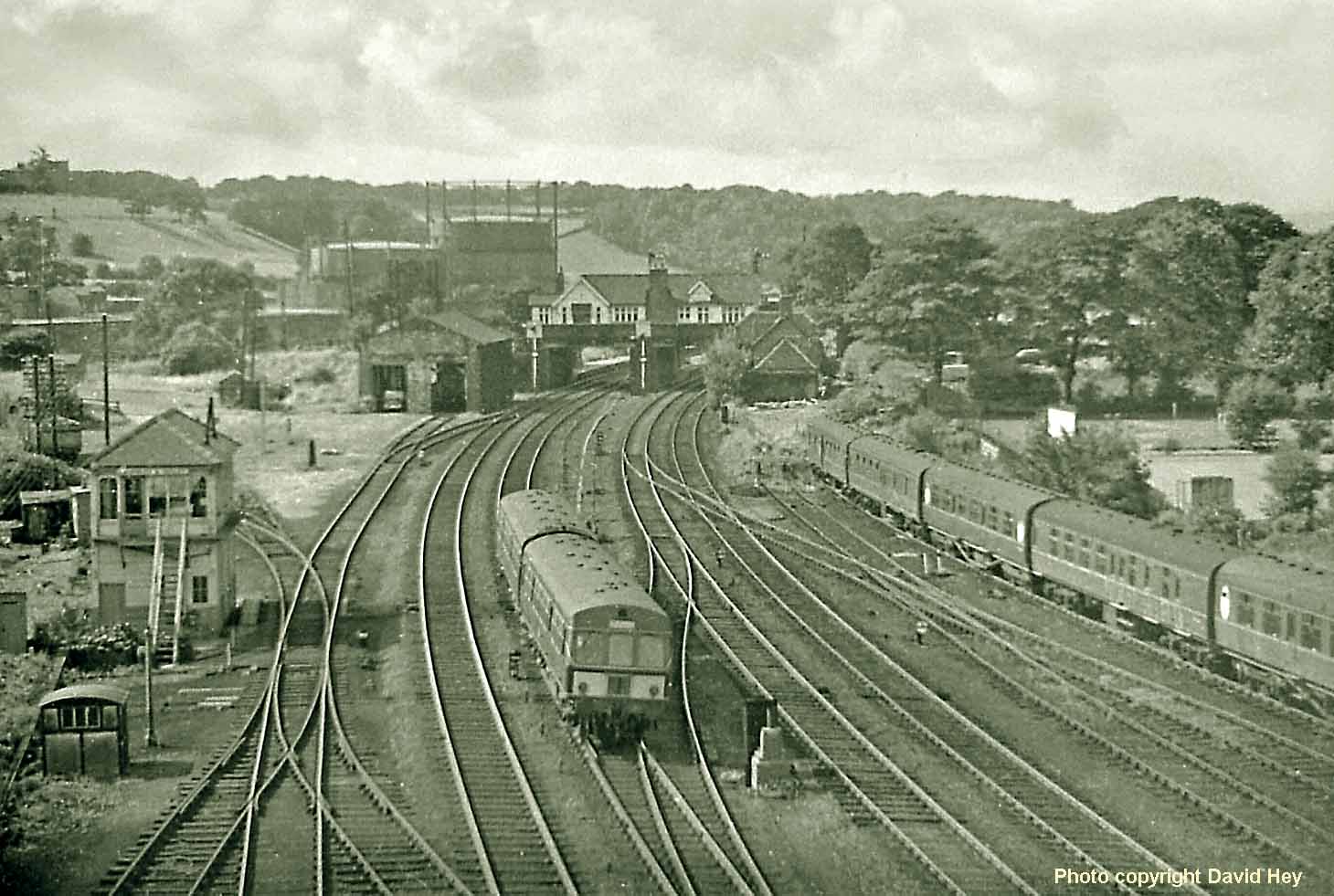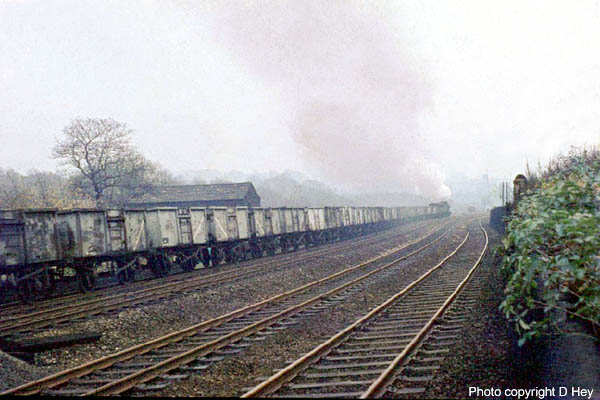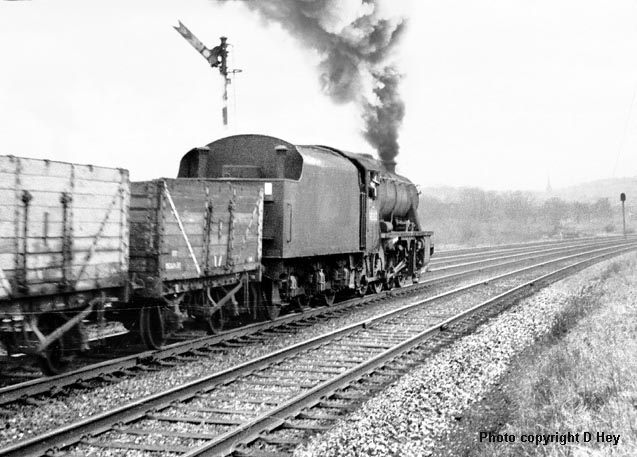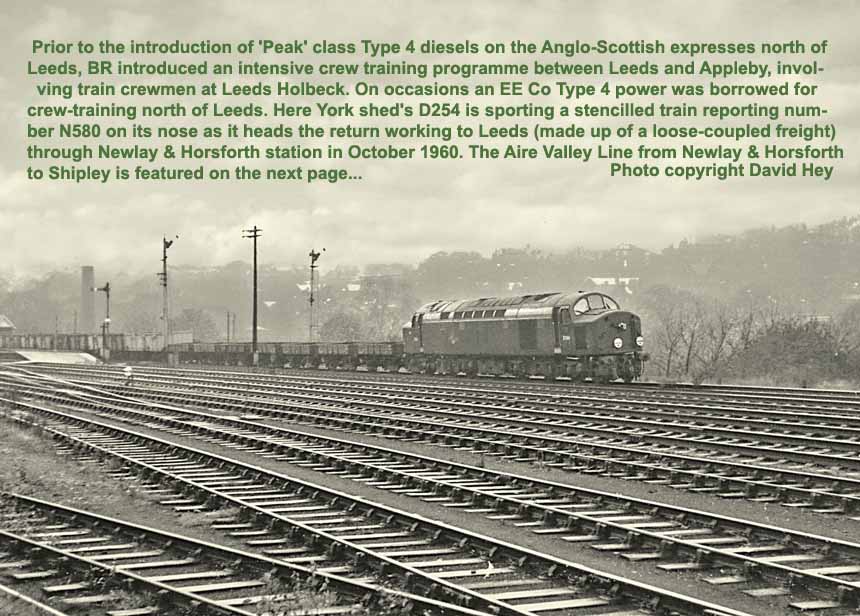A BRIEF HISTORY OF AIREDALE'S TRANSPORT
The Aire Valley's long association with the textile trade is well known; a central feature of the valley's urban landscape is the number of mill chimneys that still dominate the skyline today. In the early days, the woollen goods was transported by pack horses from the sheep-grazing upland pastures down the valley to the burgeoning hand weaving cottage industry.
In the 1760s, a plan was put forward to build a canal across the Pennines linking Liverpool and Leeds but its construction was delayed by a dispute over the proposed route missing key towns on the Lancashire side and it wasn't until some 46 years later that the 127 mile-long Leeds-Liverpool Canal eventually opened. The canal lays claim to be the longest of England's inland waterways, and the first to cross the Pennines connecting the industrial heartlands of the West Riding and East Lancashire; it certainly helped the woollen trade. The textile trade's reliance on the Leeds-Liverpool Canal can be measured by the large number of weaving and spinning mills built along its banks, a classic case being the model mill village at Saltaire founded by Sir Titus Salt.
By the early 1840s, however, the fanfare opening of the Stockton & Darlington Railway in 1825 changed everything; a group of leading industrialists in Bradford decided that a railway would provide a speedier transport system to convey their textile products, and founded the Leeds & Bradford Railway Company (L&BRC).
In 1843 the company obtained an Act of Parliament to build a line from Leeds to Bradford; the engineer chosen for its construction was George Stephenson who, like the canal builders before him, opted to use the gentle contours of the Aire Valley through Kirkstall and Rodley to reach Shipley, where the line then slewed south along a flat valley floor to a terminus at Bradford Market Street near the Canal Basin at the bottom of Kirkgate. The station was later renamed Bradford Forster Square in 1924.
(Above) There are places along the Aire Valley line where the railway inhabits a lovely green corridor and the countryside to be found between Calverley and Apperley Bridge is a case in point; the sweep of woodland down side of the valley can be seen in this view of Class 31/4 No 31404, customised with white body stripe, 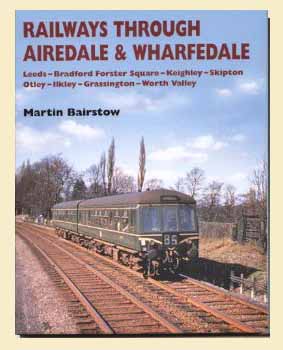 heading the 16.10 Carlisle-Leeds across the River Aire on 1 July 1983.
heading the 16.10 Carlisle-Leeds across the River Aire on 1 July 1983.
(Inset Left) A page on the Aire Valley Line would not be complete without mentioning the series of railway books published by Martin Bairstow, which includes the excellent 'Railways Through Airedale & Wharfedale', highly recommended. Click on image left to view the full series.
(Inset Right) Also mention is made of the Aire Valley Rail Users Group (AVRUG) which campaigns tirelessly to support today's rail passengers using the Aire Valley Line and the routes from Airedale to Carlisle, Morecambe and London. The Group has a close relationship with other rail user groups concerned with the promotion of a quality public transport. Click on photo-link to visit the AVRUG's website... (Below) The railway infrastructure at Kirkstall was made up of the fly-over junction embankment and numerous sidings serving the now-defunct Kirkstall Power Station; it occupied several acres, as illustrated in this view of Class A3 60092 Fairway heading the northbound 'Waverley' towards Kirkstall in June 19060. Today, the open green area has become a natural migration route for birds, and since the decline of Airedale's textile industry the improved water quality of the River Aire has seen the return of salmon and otters; indeed it's amazing how mother nature has taken its course over the years, for the urban corridor has now been designated an area of great local interest called Kirkstall Valley Park.
(Below) The railway infrastructure at Kirkstall was made up of the fly-over junction embankment and numerous sidings serving the now-defunct Kirkstall Power Station; it occupied several acres, as illustrated in this view of Class A3 60092 Fairway heading the northbound 'Waverley' towards Kirkstall in June 19060. Today, the open green area has become a natural migration route for birds, and since the decline of Airedale's textile industry the improved water quality of the River Aire has seen the return of salmon and otters; indeed it's amazing how mother nature has taken its course over the years, for the urban corridor has now been designated an area of great local interest called Kirkstall Valley Park.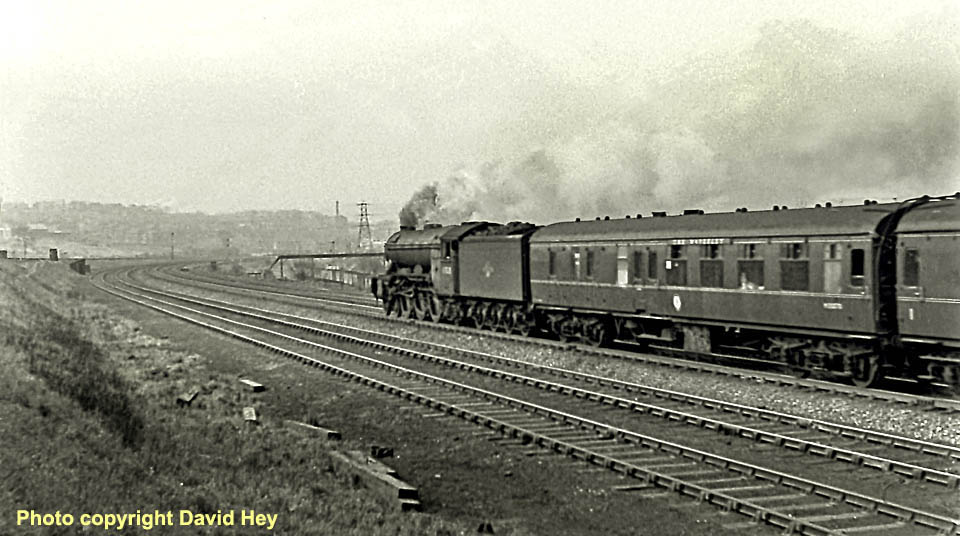
In 1845 the fledgling Leeds & Bradford Railway Company obtained a further Act to build an extension of the line through the upper Aire Valley from Shipley to Skipton and beyond to Colne. The first section opened from Shipley to Keighley on 16 March 1847, followed by a second section between Keighley and Skipton on 7 September 1847 and the final section between Skipton and Colne on 2 October 1848. The following year the North Western Railway built a line from Skipton to Clapham, and in 1850 the company extended the line through to Morecambe. Then eleven years later the North Western Railway opened a route from Clapham to Lowgill in the Lune Valley; this gave the MR access to Carlisle, but dissatisfied with the NWR's handling of its traffic to the north (the MR's control over the route ended at Ingleton), the Midland Railway opened its own line from Settle Junction to Carlisle in 1876, and this created a direct route for trains between London and Glasgow.
The opening of the S&C established the Aire Valley line as a major Anglo-Scottish rail artery.
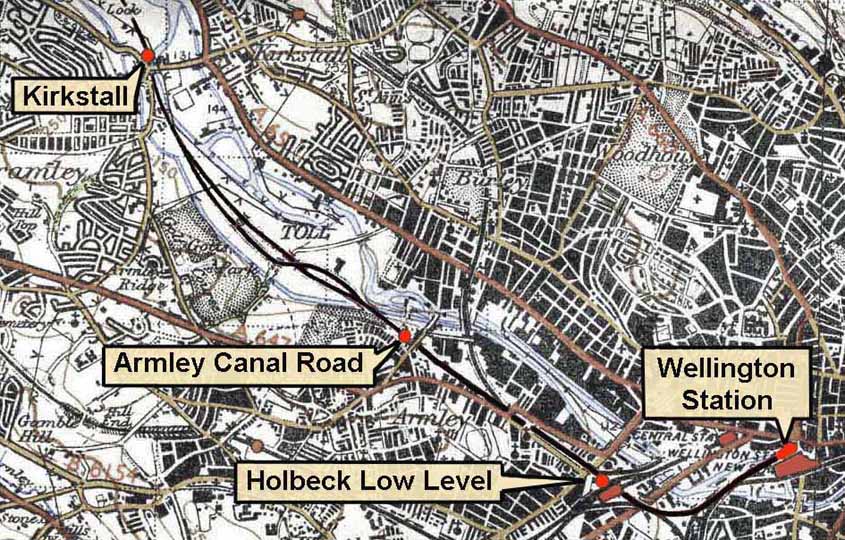
PART ONE - LEEDS TO KIRKSTALL
The growth of Leeds as a manufacturing centre owes much of it success to the railways, however the earliest industrial development of the town (Leeds wasn't granted city status until 1893) was made possible by the 1699 Aire & Calder Navigation Act which established Leeds as the highest navigable point on the River Aire from the North Sea via the Humber Estuary. Merchants came by boat to negotiate with the weavers and 'piece men' - a name given to the traders who sold lengths of woven woollen fabric ('pieces') produced on a handloom. The importance of Leeds in the woollen cloth trade can be measured by the huge volume of business it shipped overseas; this represented some 30% of the country's woollen exports to Europe.
A subsequent Parliamentary Bill to make the River Aire navigable above Leeds was unsuccessful, and this led to the construction of the Leeds-Liverpool Canal. Opened in 1816, the pioneering Trans-Pennine canal linked the sea ports of Liverpool and Hull by means of the Aire and Calderdale Navigation at Granary Wharf in the centre of Leeds (see pics below). The wharf's Lock No 1, known as River Lock, connects the Aire with the canal, and this marked the starting point...
However, a little over thirty years after its opening, the Leeds-Liverpool Canal's monopoly was about to be challenged when the railway age was borne. The first line to serve Leeds was the Leeds and Selby Railway which terminated at Marsh Lane station in 1834; this was followed by the MR's Leeds Wellington station in 1848 and the GNR's Leeds Central station in 1854. The North Eastern Railway later extended the line from Marsh Lane to connect with the London North Western Railway at a joint LNWR-NER Leeds 'New' station in 1869. Both companies had previously shared facilities with the MR at the adjacent Wellington Street station. In 1938 both Wellington and New stations were linked and renamed Leeds City.
This is where our journey through the Aire Valley begins….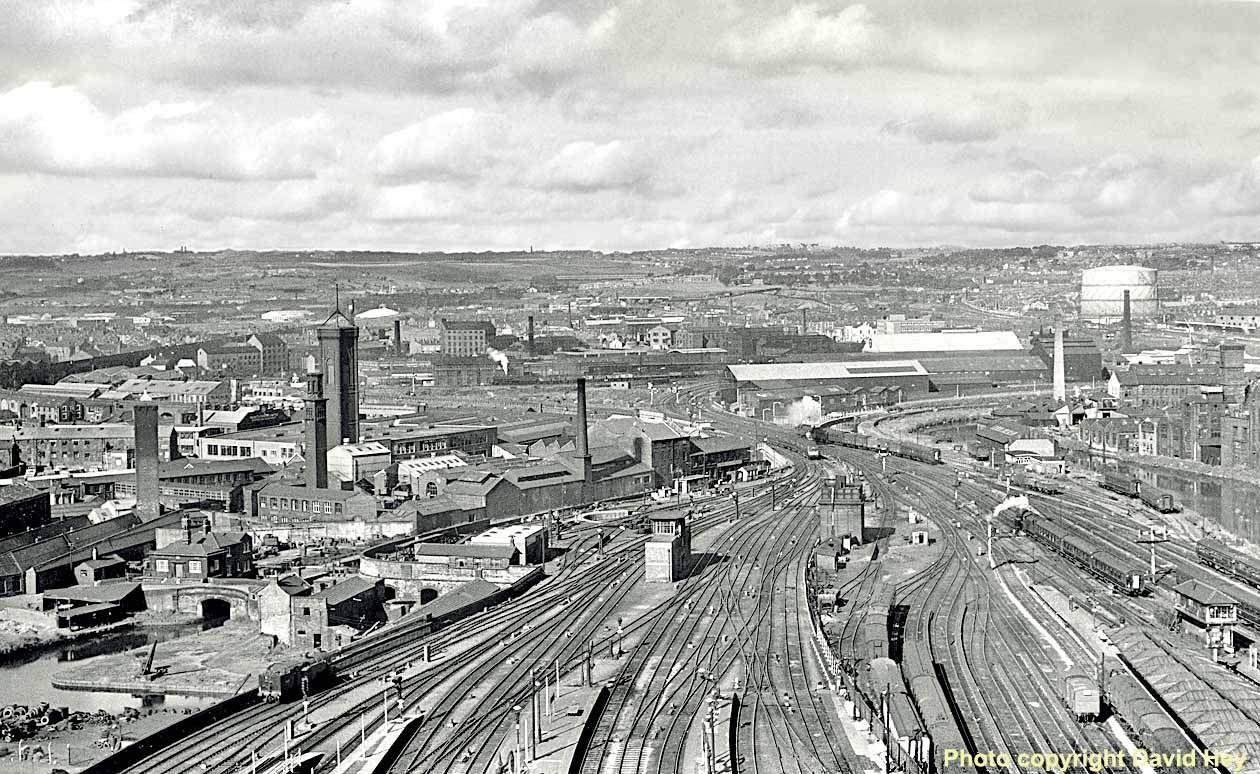
(Above-Below) During the Sixties BR made radical changes to the Leeds rail network with the complete closure of Leeds Central Station, terminus of the former GNR line from Doncaster, with connections to Bradford and to the north via Harrogate. The scheme to combine the rail facilities at Central station into one reconstructed and modernised City station was a particularly slow affair taking eight years from BR's first announcement in June 1959. Working with financial expediency in mind, trackwork was replanned to accommodate a newly-installed link from Whitehall Junction enabling Doncaster and Kings Cross traffic access to the new station. When the GNR Central station closed its doors on April 29th 1967 all train services were diverted into Leeds City the following morning. Today's rail commuters will barely recognise this scene (above) or the one (below) taking some twenty-odd years apart; indeed the railway layout at Leeds has radically changed in recent years, particularly since the erection of steel masts and a curtain of overhead wires for the £306 million East Coast Main Line electrification scheme which connected the city with the main line at Doncaster in 1989. In the top mid-1960s view, the former MR Wellington station can be seen in the right foreground; a Black 5 is departing whilst a Stanier tank fusses about with some parcel vans and a Metro-Cammel DMU heads past Leeds City East Junction, formerly Canal Junction, and in the far distance a WD heads a southbound freight on the goods avoiding line between Whitehall Junction and Engine Shed Junction. On the extreme right, next to the gas holders (now the site of the present-day Armley gyratory road system) are the platforms of Holbeck High Level station on the line into Leeds Central. In the left foreground is the inner-city canal basin, Granary Wharf, seemingly in a very rundown state, but the site has been transformed beyond all recognition in recent years, whereas the dust extractor tower (a copy of the famous Giotto's campanile at Florence) in the middle distance remains a familiar landmark. Comparisons can be made with the 1980s view below, which captures the exhaust of a 1C125 arriving from London Kings Cross...the eagle-eyed visitor may spot a 'Peak' class in the middle distance.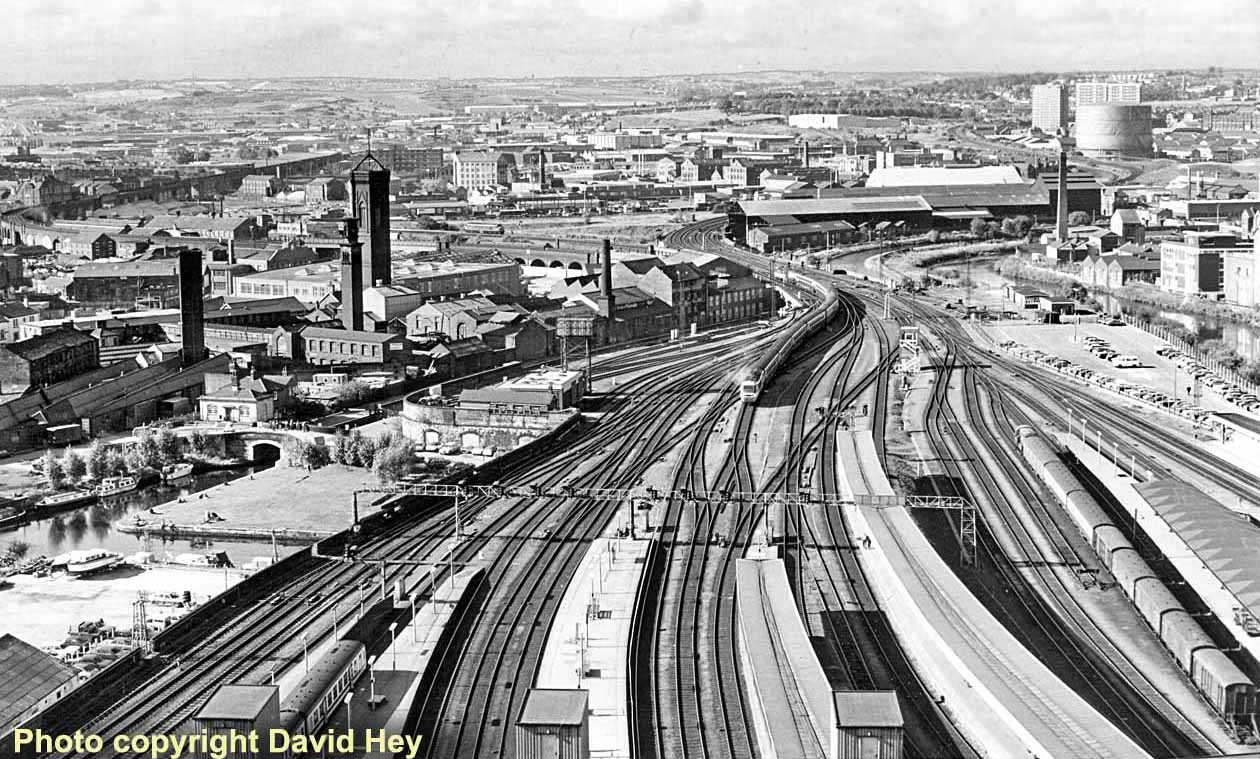
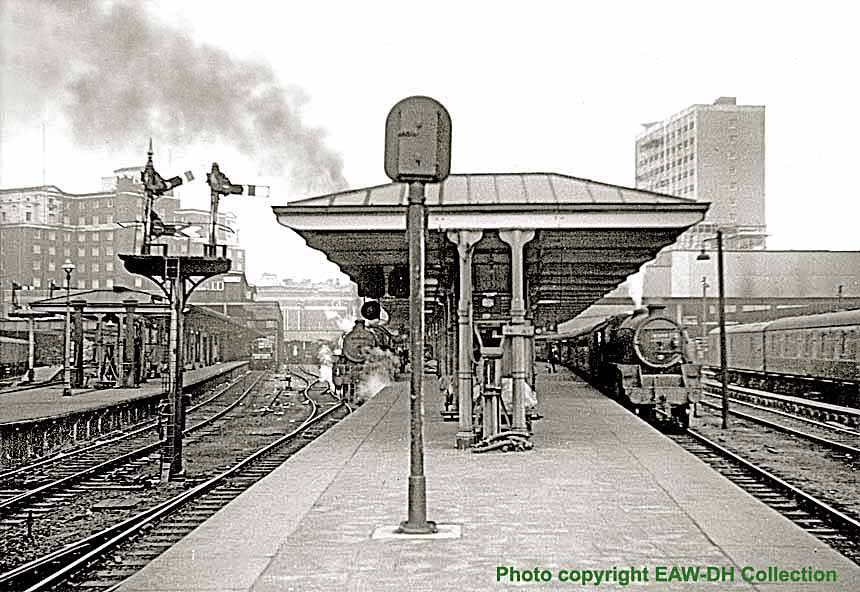
(Above) The Anglo-Scottish expresses on the MR route from St Pancras to Glasgow had to reverse at the Leeds, including the 'Thames-Clyde Express'. Perhaps older enthusiasts will recall a summer timetable in the Fifties when both 'up' and 'down' trains were booked to arrive at Leeds at the same time - approximately 14.30. However, because of the length of both trains, the island platform 5-6 had to be used, therefore passengers entering the station found themselves facing two identical expresses standing side-by-side, each carrying non-reversible 'London-Leeds-Glasgow' roof boards on the carriages, and as both the 'up' and 'down' trains arrived and departed in the same direction, the station staff had to make sure that a hapless passenger didn't end up travelling in the opposite direction they intended! It later transpired that Skipton became the passing point. Here, a pair of Black 5's await departure from Wellington Street station in June 1966. Much of what you see here is now car park.
I've recently received a chatty email from Tony Chabot, who writes...
'I happened upon your site when researching the date diesel trains began in Leeds. I remember my father taking me to Leeds City station to see an early one, surrounded by steam trains. But your website says that the first dmu began in 1954, and I doubt I would have such memories from when I was only two.
However, I do have vivid memories of a winter trip, when we changed trains at Shipley (my parents had friends in Keighley, so I assume we were on the way home from a visit). A steam train came thundering through the station, much bigger than the one we had caught, and I was eager to stay on the platform to watch more  exciting trains. But my parents dragged me into a tiny waiting room which had a feeble fire in the corner. They huddled around it. It's odd how excited kids do not feel the cold (I remember my grandfather describing being cold as 'starved').
exciting trains. But my parents dragged me into a tiny waiting room which had a feeble fire in the corner. They huddled around it. It's odd how excited kids do not feel the cold (I remember my grandfather describing being cold as 'starved').
For a time we lived close to the Middleton Railway when there were still tracks going quite far up the hill, but they are long gone. The worst legacy of Beeching is the increase of entropy (forgive my scientific term) • see note below. After all, railway companies spent a fortune buying land for tracks, yet the post-Beeching bits of the land have now been sold off and built over.
Strange how memories work, I suddenly remembered a sort of giant 'Dymo' writer that produced embossed metal strips. It was in the hall that fed in from City Square.
Excellent site: keep up the good work, Tony Chabot'
• entropy is a measure of the disorder that exists in a system (sums up the Beeching era perfectly).
(Inset) Tony's reference to the 'Dymo' writer prompts me to mention Douglas Bryce and others who recall the metal nameplate stamping machines manufactured by the British Automatic Company Ltd; the machines could be found at most mainline railway station in the 1950s…visit the excellent Edinphoto.org website HERE for a trip down memory lane. (Below) A carriage print featuring Leeds City Station Concourse by Claude Buckle from the LMR Railway Architecture Series, was recently sold by the specialist railwayana and transport auctioneers, Great Western Railwayana Auctions, one of the longest established railwayana auction house still under the same ownership. Click HERE to visit the GWRA's excellent website. 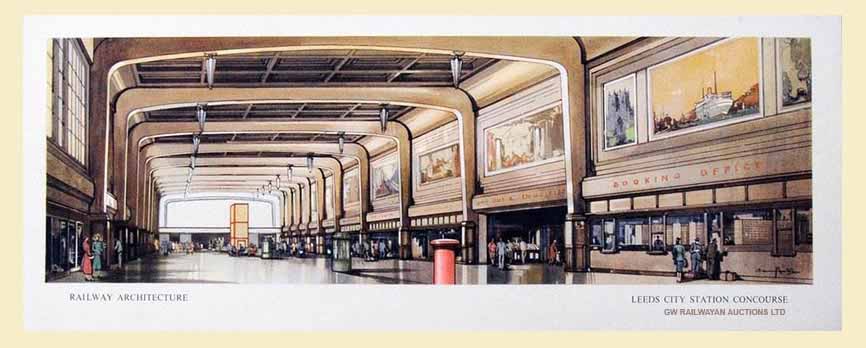
(Below) Footplate Cameraman, Jim Carter, worked almost 30 years in the footplate grade, starting first as a cleaner, then moving onto firing and ultimately driving while based at Patricroft shed in Manchester. He regularly fired on the Liverpool-Newcastle jobs between Manchester and Leeds, and this gave him an opportunity for a few hours photography before returning to Manchester; he captured this shot of EE Type No D285 sporting a stencilled train reporting number N580 as it heads an interesting collection of articulated coaching stock at the start of a driver training run to Appleby. Prior to the introduction of 'Peak' class Type 4 diesels on the Anglo-Scottish expresses north of Leeds, BR introduced an intensive crew training programme over the Settle-Carlisle, involving train crewmen at Leeds Holbeck. Before diesel facilities were made available at Holbeck, a pair of BR Sulzer Type 4s Nos D11 and D14 were allocated temporarily to Leeds Neville Hill for the purpose. On occasions, however, EE Co Type 4 power was borrowed for crew-training north of Leeds. Leeds Wellington station can be seen on the left.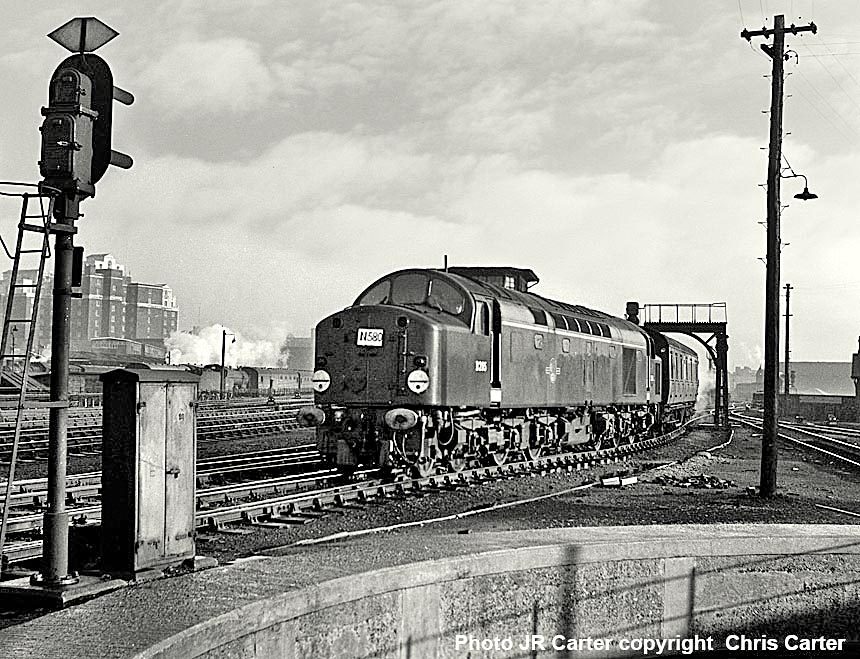
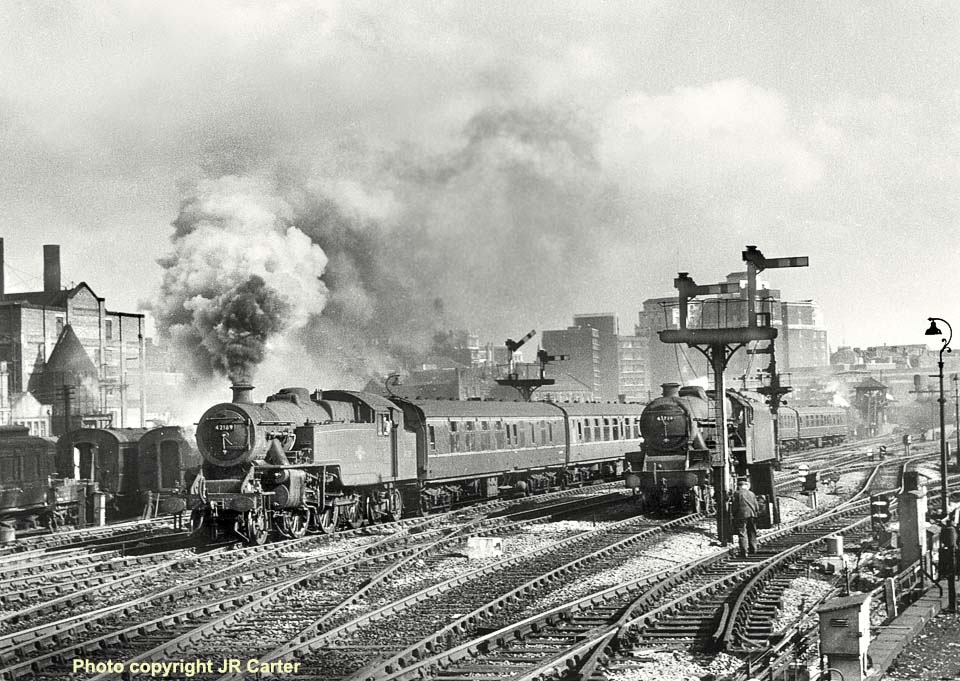
(Above-Below) Another poignant record of Jim's visits to Leeds is this shot of Fairburn 2-6-4T 42189 departing Wellington station on the final leg to Bradford Forster Square with a train from St Pancras. On the right, Holbeck's 'Jubilee' class 45739 Ulster awaits the arrival of the 'up 'Devonian' express from Bradford to continue the journey south (Below) The former MR Leeds Wellington terminus was essentially a station of two halves, north and south, each with its own arrival and departure platforms used by trains from the south via Sheffield to St Pancras, and to the north via Shipley with connections to Bradford Forster Square, Ilkley and to Skipton and the S&C to Scotland. Class A3 No 60082 Neil Gow heads out of Wellington Street station with the 10am to Glasgow. The chimneys on the left belong to the Leeds Corporation power station on Aire Street. 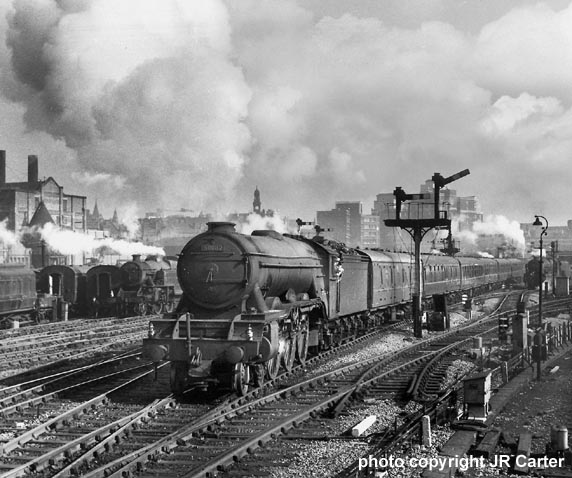
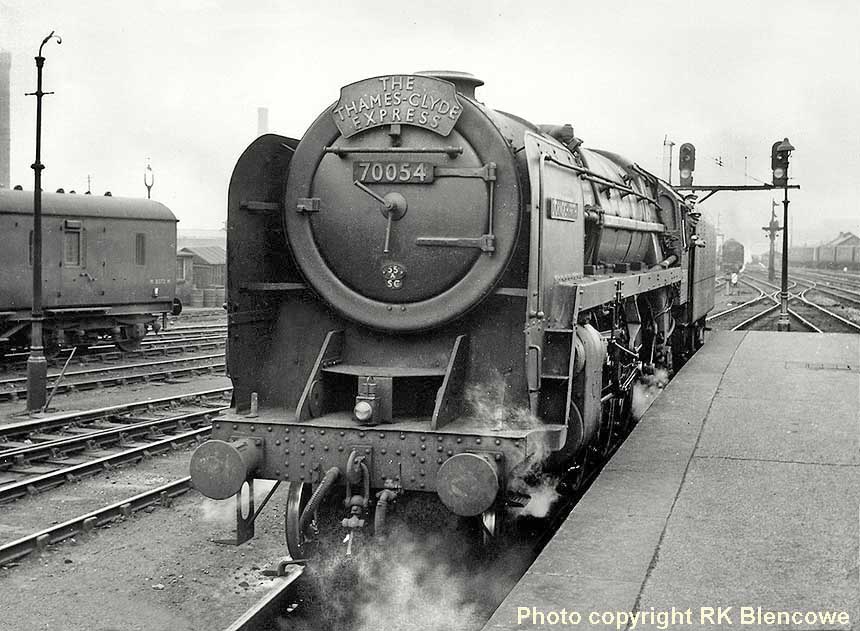
 (Above) After arriving at Leeds Wellington station with the southbound 'Thames-Clyde Express' on 8th May 1959, the crew of 70054 Dornoch Firth await signals before backing out of the platform for Holbeck shed. 70054 was the last of the 'Britannias' to be built at Crewe in September 1954, just short of four years since the first of the class, No 70000 'Britannia' was constructed. 70054 was allocated new to Glasgow Polmadie (66A) where it spent just over four years. 70054 then moved to Leeds Holbeck MPD (55A) at the start of November 1958, along with 70053 Moray Firth, spending 3 months short of four years there before moving to Crewe North MPD (5A) in August 1962. The last shed was Carlisle Kingmoor, where 70054 was withdrawn on 26 November 1966. Full details of all the 'Britannia' class locos can be found on Derek Dean's Pages 91-92 featuring a step-by-step history of each loco.
(Above) After arriving at Leeds Wellington station with the southbound 'Thames-Clyde Express' on 8th May 1959, the crew of 70054 Dornoch Firth await signals before backing out of the platform for Holbeck shed. 70054 was the last of the 'Britannias' to be built at Crewe in September 1954, just short of four years since the first of the class, No 70000 'Britannia' was constructed. 70054 was allocated new to Glasgow Polmadie (66A) where it spent just over four years. 70054 then moved to Leeds Holbeck MPD (55A) at the start of November 1958, along with 70053 Moray Firth, spending 3 months short of four years there before moving to Crewe North MPD (5A) in August 1962. The last shed was Carlisle Kingmoor, where 70054 was withdrawn on 26 November 1966. Full details of all the 'Britannia' class locos can be found on Derek Dean's Pages 91-92 featuring a step-by-step history of each loco.
(Below) A Class 8F heads a southbound empty mineral train at Whitehall Junction in July 1962. The train will take the r/h spur to Engine Shed Junction at Holbeck. The tracks curving left lead into Leeds Wellingon and City stations; these were joined by the ex-MR line from Holbeck and the the south at Leeds City North Junction. These were then joined by the ex-LNWR lines which crossed the viaduct from Farnley Junction to Canal Road Junction on the western approach to Leeds City and Wellington stations. (Above right) The apex of the triangular junction (a recessed-wall area on the rail bridge above Globe Road) was a favourite place for observing trains coming and going in all directions! 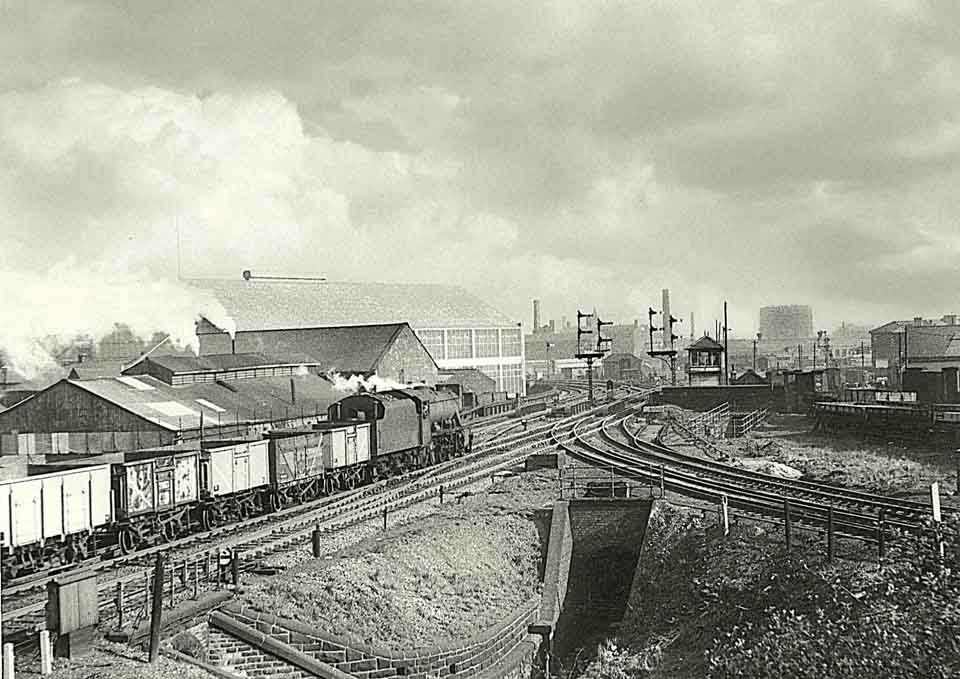
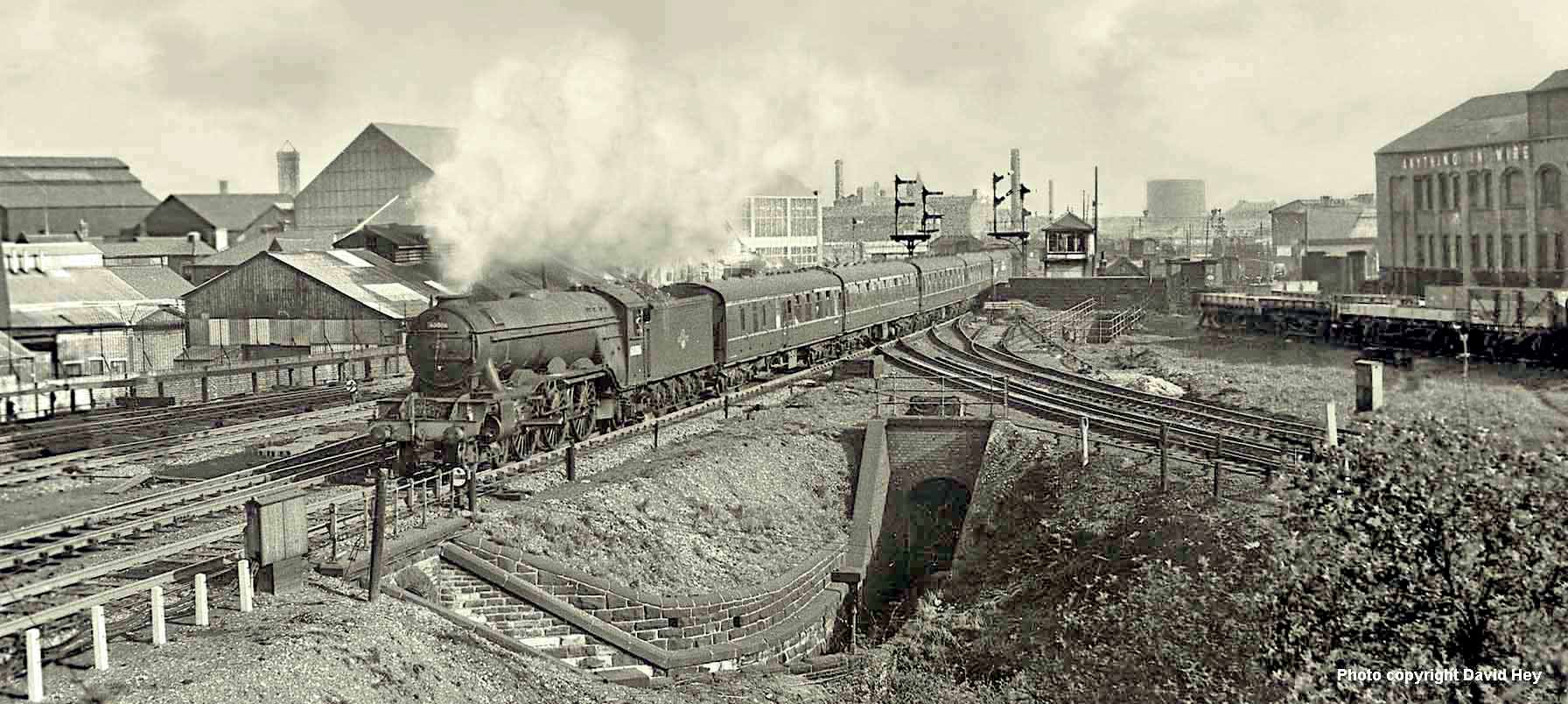
(Above-Below) I have fond memories of photographing the two Anglo-Scottish expresses between Leeds and Shipley; a variety of steam power worked both expresses north of Leeds - 'Jubilees', 'Scots' and BR Standard 'Britannia' classes, all based at Holbeck shed - but the most surprising allocation was the nine Class A3s transferred from Tyneside due to the cascading effect of dieselisation on the ECML. On paper the A3s were Holbeck engines, yet all heavy maintenance such as boiler wash outs were done at Neville Hill. Nevertheless the newly-acquired A3s were welcomed by Holbeck crewmen, as most were fitted with the double Kylchap blastpipe which produced a freer steaming engine and gave fireman an easier time over the steeply-graded Settle-Carlisle line. Here Class A3 No 60086 Gainsborough heads the northbound 'Thames-Clyde' though Whitehall Junction in May 1961. The two turntables at Holbeck were found unsuitable for turning the Gresley Pacifics - length 70ft 5ins - hence sister A3 No 60082 Neil Gow (just visible in the right background) is being turned on the triangular junction to the west of Leeds station, while an 'Austerity' is awaiting a clear road on a down freight. (Below) Fast forward twenty-odd years and Whitehall Junction has radically changed. This 1983 view shows one of the 'First Generation' Class 108 dmus which were built to designs conceived during the 1950s, but by the time this photograph was taken the units were way past their best. BR began a refurbishment programme in 1975 (repainting, improved heating and ventilation, soundproofing and general improvements to the interior) which may have been tangible proof of the worthiness of the old stock, but it underlined the desperate need for more modern vehicles; it wasn't until 1984 that BR embarked on the replacement of its existing fleet with the introduction of the second-generation dmus, including the new Class 14X 'Pacer' and Class 15X 'Sprinter' types. I sat here for hours watching trains coming and going; the junction is less than a mile from the city centre, yet the grassy bank was like a green oasis amidst the industrial setting and busy Armley gyratory road system.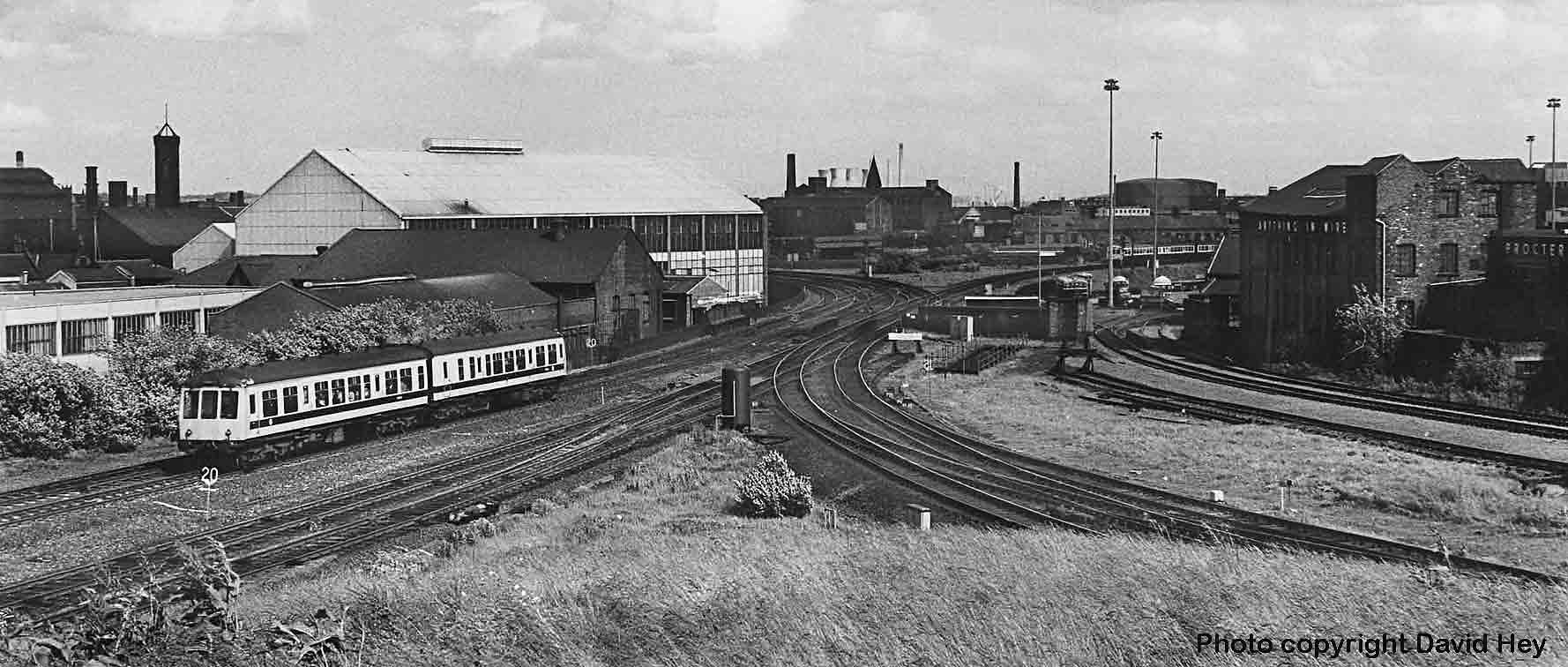

(Above-Below) With the digital age gathering pace, rail enthusiasts can now engage their interest in trains in a variety of ways. Among the most recent is the penchant for digital modelling using computer software. This enables an operator to build a working model and simulate train services and cab rides. Either way, it takes a great deal of skill and patience to create an accurate computer model, such as thoroughly researching the route's history in order to accurately replicate the railway infrastructure in a particular year: station buildings, track layouts, embankments, cuttings, bridges and tunnels, and the numerous signal boxes demolished years ago when the old-fashioned semaphores were replaced by colour lights. Here are two screenshots from Keith Rigby's computer simulation of the Aire Valley Line between Leeds and Skipton in the early Sixties. He writes - 'I worked on the route using Microsoft Train Sim, but gave it up last year when a new version of train simulator came out (TS2013) which is more realistic due to the depth of colours etc. However it comes at a price…'
Keith makes a valid point. When indulging in our hobby we rarely factor in the costs involved, but in today's digital world users of the Internet have no choice! The only way to improve our web experience is by frequently updating or upgrading to yet another 'improved' version of the latest software costing goodness knows what!…I'm still sore at Microsoft for ditching my beloved Windows XP!
Okay, perhaps some of the buildings in Keith's screenshots could be improved upon with the latest software, but that's not the point! Let's not forget that this is a hobby - Keith did it for himself, and no one else. These screenshots will revive fond memories of spotting days for many old-timers like me and I am delighted he's sharing them on this site.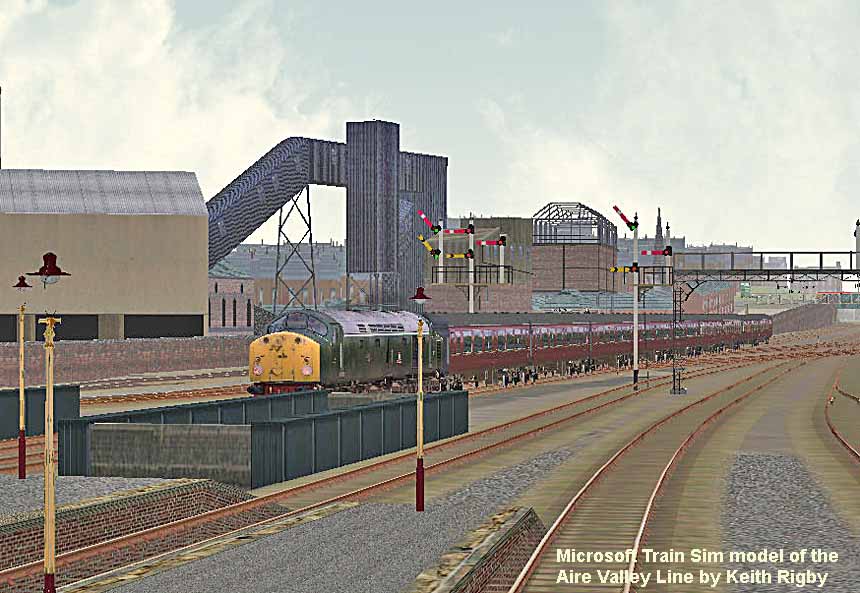
(Below) A scene now radically changed following construction of the Armley gyratory road scheme as part of the new Leeds Inner Ring Road system in the early 1970s. Here Class 4F No 44315 heads a train of empty fruit wagons through Holbeck Low Level station on 8 September 1951. In the foreground are the steps leading down to the station entrance on Wellington Road; the eagle-eyed might spot a Horsfield tram heading down Armley Road in the distance.
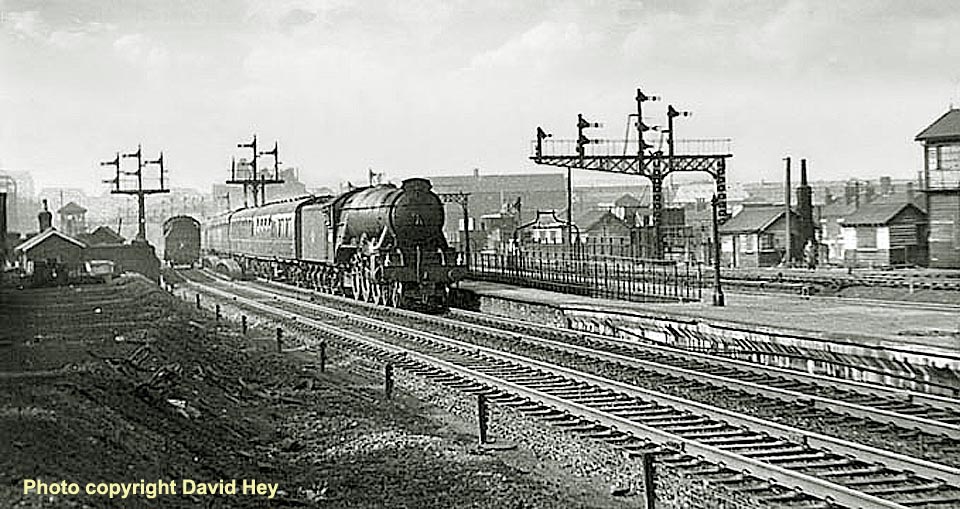
(Above) Holbeck's Class A3 No 60082 Neil Gow passes the disused platforms at Holbeck Low Level with the 'up' 'Thames-Clyde Express in May 1961. The lattice signal gantry on the right controlled traffic to  Wellington Street Goods Depot and Central station. On the left are siding serving the gasworks, and in the middle distance the former MR Wortley Junction signalbox. The name Wortley Junction is now given to the present-day divergence of the Harrogate line from the lines to Skipton and Ilkley near Armley Bridge. Holbeck Low Level station closed on 5th May 1958. (Inset Left) This 'Neil Gow' nameplate from Class A3 No 60082 sold for £7,600 at the GCR's April 2011 auction. One of the great joys of surfing the Internet is visiting the Railwayana Auction websites which feature so many interesting facts hitherto unheard of. For example,
Wellington Street Goods Depot and Central station. On the left are siding serving the gasworks, and in the middle distance the former MR Wortley Junction signalbox. The name Wortley Junction is now given to the present-day divergence of the Harrogate line from the lines to Skipton and Ilkley near Armley Bridge. Holbeck Low Level station closed on 5th May 1958. (Inset Left) This 'Neil Gow' nameplate from Class A3 No 60082 sold for £7,600 at the GCR's April 2011 auction. One of the great joys of surfing the Internet is visiting the Railwayana Auction websites which feature so many interesting facts hitherto unheard of. For example,  although 60082 took its name from the racehorse which won the 2000 Guineas in 1910, I now learn that the horse itself was named after a celebrated violin player and composer of traditional Scottish airs (1727-1807) in whose memory the Annual Scottish Fiddle Festival is held. (Inset Right) This locomotive headboard, measuring 40" x 17½" sold for £3,600 at a GCR auction on 18 July 2009. Click here to visit the Great Central Railwayana Auction's fascinating website.
although 60082 took its name from the racehorse which won the 2000 Guineas in 1910, I now learn that the horse itself was named after a celebrated violin player and composer of traditional Scottish airs (1727-1807) in whose memory the Annual Scottish Fiddle Festival is held. (Inset Right) This locomotive headboard, measuring 40" x 17½" sold for £3,600 at a GCR auction on 18 July 2009. Click here to visit the Great Central Railwayana Auction's fascinating website.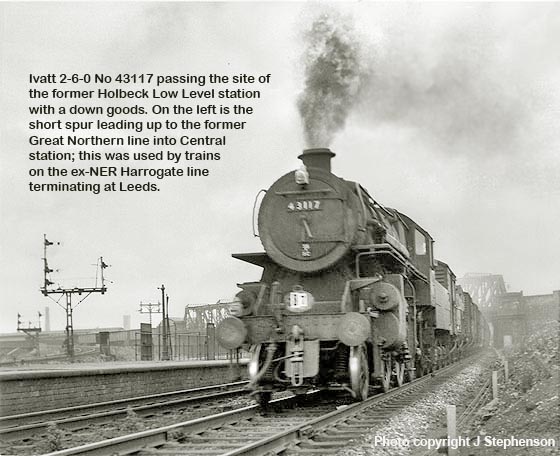




(Above-Below) Retired railway signalman Keith Long's 'Cabsaab900' Flickr website contains some superb shots of steam days at Leeds, including these two taken from Wortley North signalbox of 'Jubilee' class No 45562 Alberta drifting past Wortley Junction with a Carlisle Kingmoor to Birmingham Washwood Heath express freight 4th March 1967. In the background is the New Wortley Gasworks, and just visible on the skyline the imposing outline of Armley Jail. (Below) Swinging the camera to the right, Keith captures No 45562 again, this time passing beneath the splendid signal gantry of no fewer than sixteen arms, with the 3M41 08.35 Heysham to Leeds Parcels train on 7th February 1967. The chimneys of Kirkstall Power Station can be seen in the distance, and just out of shot to the left was a siding that dropped down through the wall and across the road, allowing access into the Leeds Corporation Gas Works. Most of the area has now been swept away by the Armley gyratory road system, the sidings have also vanished, replaced by industrial units. These pictures were taken just a few weeks prior to the final stages of the resignalling at Leeds and the commissioning of the new Leeds power box (PSB). Keith took several pictures at this time; all can be found on his Flickr site HERE.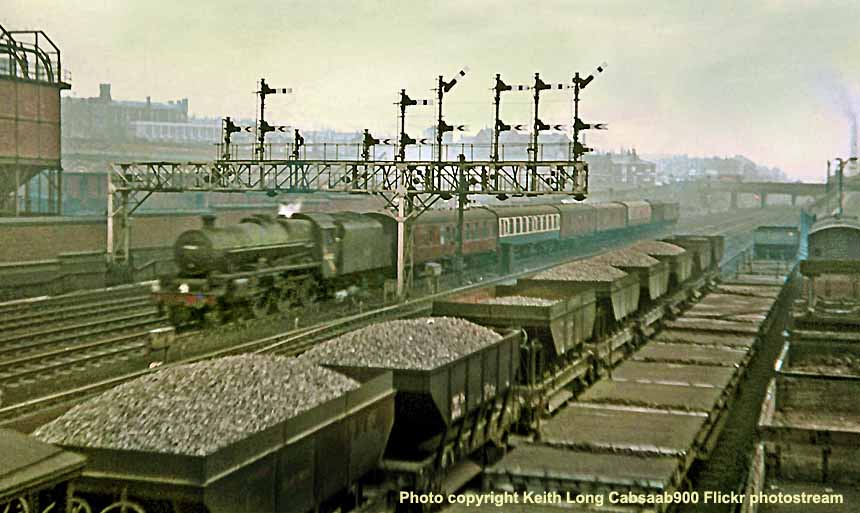

(Above-Below) Railway photography was an exciting pursuit before the new-fangled diesels arrived on the scene; the absence of anything remotely interesting to photograph (diesels all looked the same to me) taxed your ingenuity to the limit. How do you take an interesting picture of a square box on wheels? But attitudes do change as we get older and the past becomes another story altogether; the decades have their own codes and customs, even their own language…there were years when everyone was 'giving it 110 percent', 'going the whole nine yards, 'pushing the envelope', taking it to the next level', 'thinking outside the box', 'getting into bed with one another', 'brainstorming', 'running things up the flagpole', 'touching base' and 'singing from the same hymn sheet'. Today everyone seems to be having having incredible life-changing 'wake-up calls'...mine came when I scanned some old negatives from the 1980s; okay it was hardly life-changing, but it made me realise that shots of preserved steam now take second place to those of diesels; that's because so much has changed over the past 30-odd years. Not only have the diesels gone, so too has a large chunk of our railway infrastructure, much of it obscured by copious clouds of smoke in our old steam shots. This photo of the now-preserved 'Black 5' 5306 heading the 'Scarborough Spa Express' out of Leeds is a good example; compare it to the shot (below) of Class 40 40122 (EE Type 4 No D200) which was taken at almost the same spot on 10th September 1981. 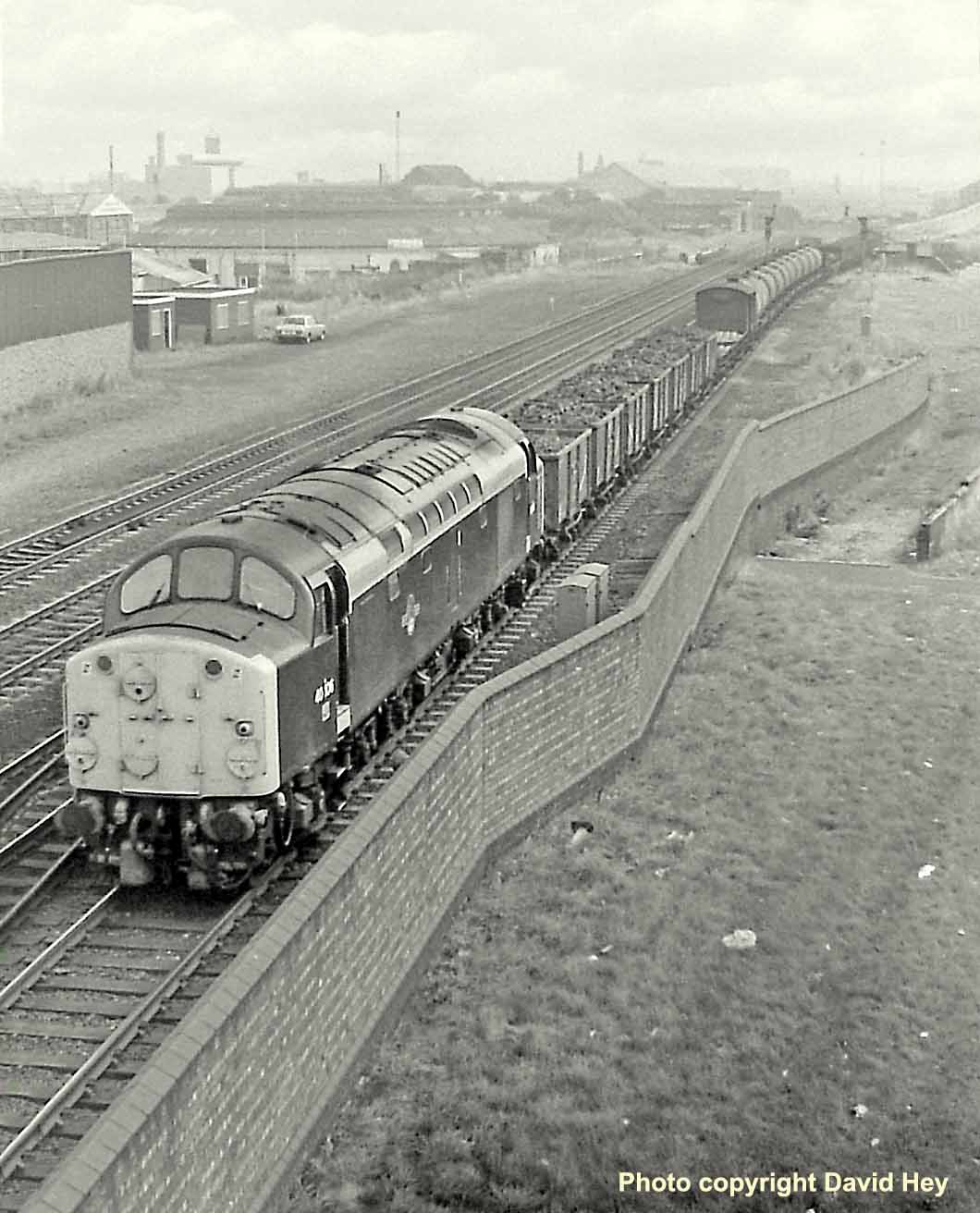

(Above-Below) This wider view gives a clearer picture of the background; on the right is the Armley Gyratory where the A58 joins the Leeds Inner Ring Road, designated a motorway A58(M) and A64(M) leading to York Road on the opposite side of the city. However, of greater interest to railway historians is the Grade II listed circular building in the left background; opened in 1847 by the Leeds & Thirsk railway the roundhouse contained a turntable serving twenty stalls, but by 1889 the stalls were too small to accommodate the larger engines being built; the shed's allocation was moved to a new shed at Neville Hill in 1904. A great selection of shots of the roundhouse can be found on the superb 'Lost Railways of West Yorkshire' website HERE. (Below) Looking in the opposite direction a 2-car dmu approaches on the Harrogate-Leeds service; the Aire Valley Line continues directly ahead.

(Above-Below) Opened in September 1847, Armley station consisted of two long island platforms in a deep cutting; the station was renamed Armley Canal Road on 25 September 1950. We are less than three miles of Leeds city centre, and the railway is following the urban corridor of the Leeds-Liverpool Canal and River Aire through Kirkstall where the architectural relics of the industrial revolution can still be found, albeit much of it is now obscured by mother nature taking its course; indeed it's hard imagine the valley's industrial past following the demolition of Kirkstall Power Station. All around a rejuvenated green landscape now prevails and what's left of the valley's industrial heritage is merged into the background. Just off Armley Canal Road is the Leeds Industrial Museum at Armley Mills beside the Leeds-Liverpool canal; the museum occupies a woollen mill built by Benjamin Gott in 1805. Following closure in the mid-Sixties, the neglected mill was turned into a working museum which also houses a great collection of narrow gauge railway locomotives amongst its exhibits …click HERE to visit the museum's website. (Below) The giant cooling towers and twin chimneys of Kirkstall Power Station dominate this view of Fairburn 2-6-4T working bunker first with a Bradford Forster Square-Leeds train which will reverse at Wellington station to continue its journey south to London St Pancras. For operational reasons the NER adopted a policy of using tank engines on express workings between Leeds and Bradford to avoid the untidy operation of turning the locomotive at terminals. 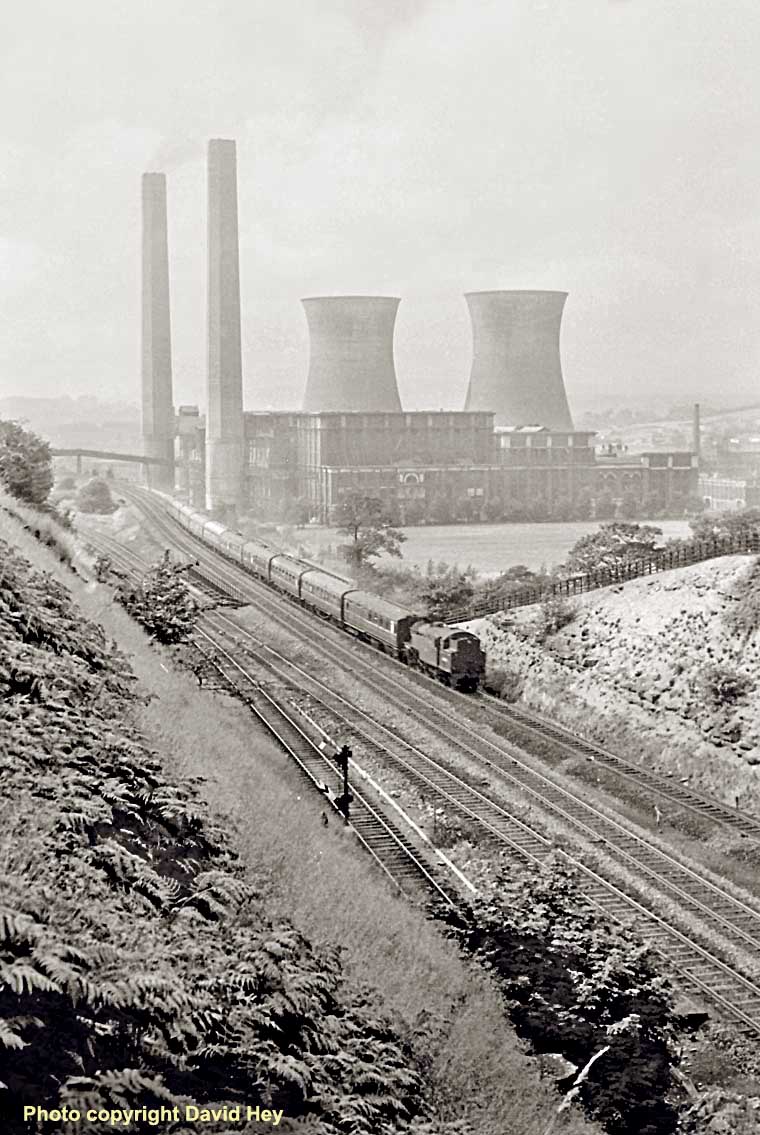
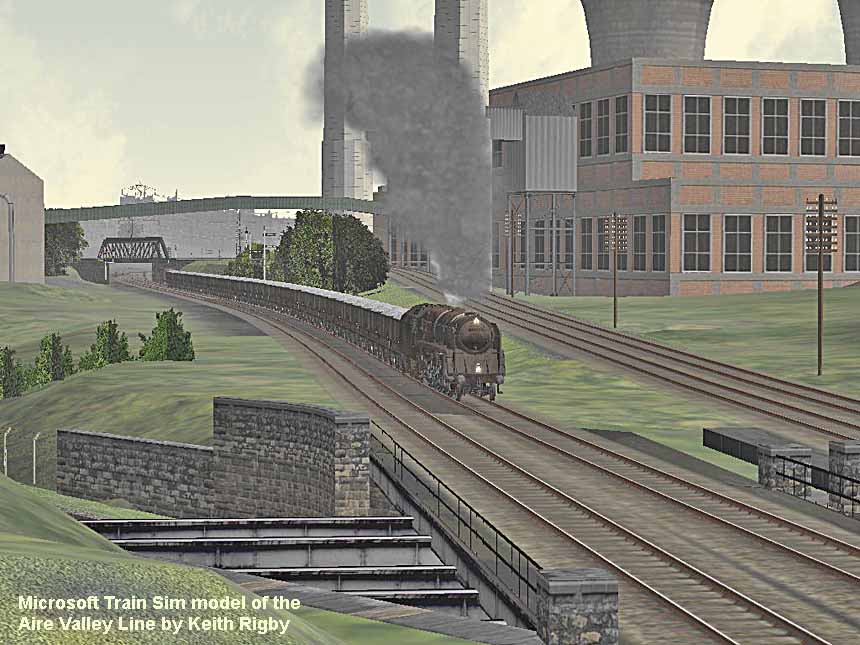
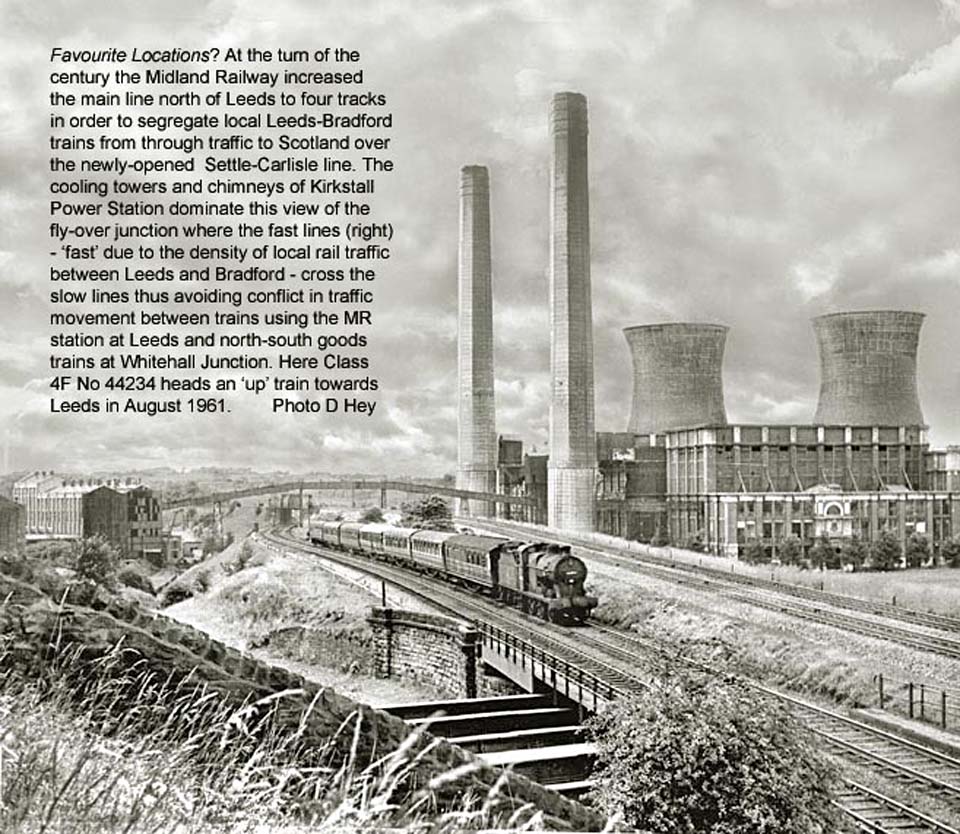
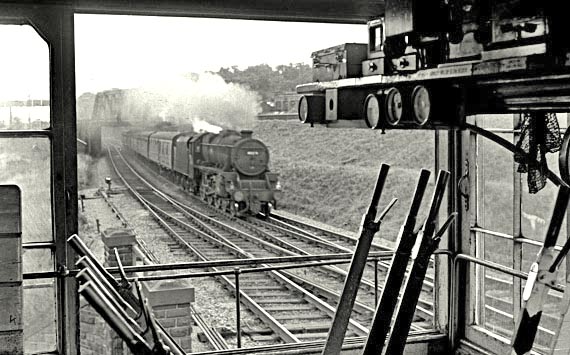
(Above-Below) (Above-Below) Having worked forty five years in signalboxes, retired signalman Keith Long had access with his camera to places on the BR network that the rest of us could only dream of! This was the view he had of the 'down' slow line from Armley Canal Road No 2 box...'Black 5' 45328 passed beneath the flyover junction with the 1M46 13.52 Leeds-Carnforth on 19 September 1965. (Below) Keith also took this shot of Armley Canal Road No 2 signalbox on 2nd August 1965. The name on the signalbox diagram was Armley Canal Junction, a reminder that the Midland Railway called anything a junction where there was so much as a siding! This Midland Railway box opened 12th December 1889 and closed when the Leeds PSB signalling scheme was commissioned on 23rd April 1967. Click HERE to visit Keith's Flickr photostream 'Cabsaab900'...well worth a visit. 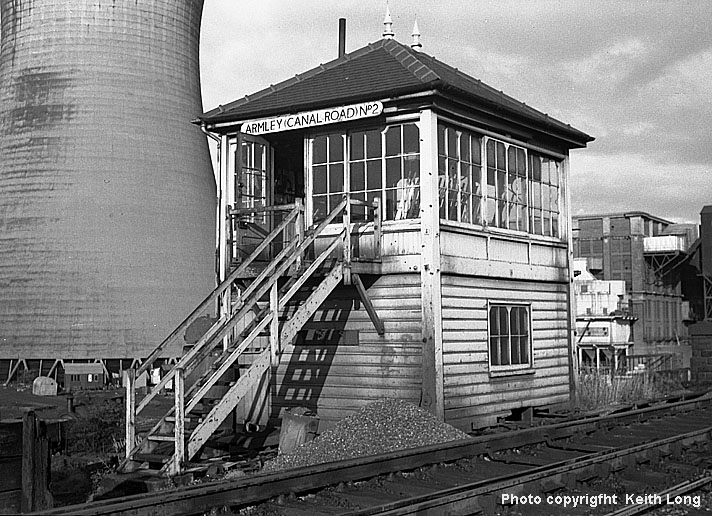

(Above-Below) At the turn of the century, the MR main line between Leeds and Shipley was increased to four tracks, and this involved the construction of a flyover junction at Kirkstall to segregate local Leeds-Bradford trains from through traffic to Scotland over the Settle-Carlisle line. Somewhat confusingly the lines used by local trains between Leeds and Bradford Forster Square were designated the 'fast' lines due to the higher volume of traffic while the Anglo-Scottish trains used the 'slow' lines. Here a 2-car Derby Class 114, adorned with white cab roof ends and yellow warning flashes, dubbed 'cats whiskers', heads towards Leeds. In the foreground an unidentified 'Peak' class heads the northbound 'Thames-Clyde Express'. 
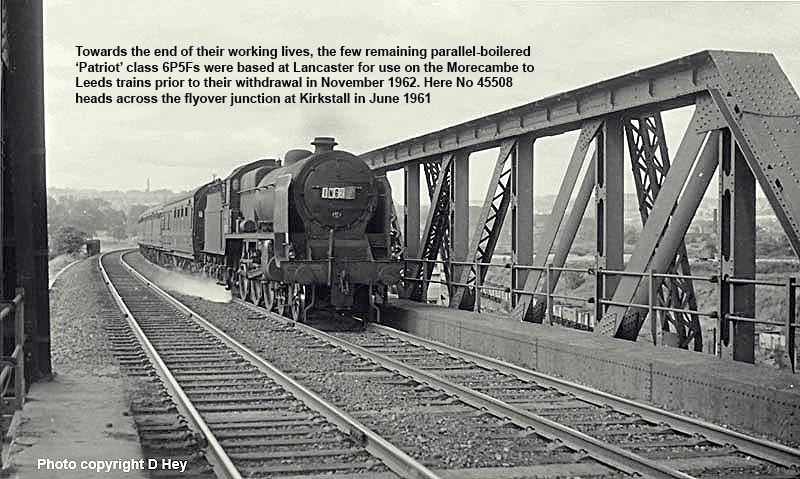
I've received a chatty email from David Baldwin, who writes: 'Hi David, visiting you Aire Valley Line pages reminds me of the occasion when, after a day's 'spotting' at City, we were returning to Keighley on the 3.14 Morecambe/Carnforth train and the 'down' Thames-Clyde was running half-an-hour late.
In those days, as your images show, the line was four-track up to Shipley and, although the Morecambe train departed on time, the Thames-Clyde set-off 29 minutes late. Both trains were on adjacent platforms and we had been hanging-out of the windows exchanging banter with two Glaswegians who were also hanging out of their carriage window, slightly the worse for wear, and clinging onto almost empty bottles of 'Johnnie Walker Red Label'.
On that Saturday the Thames-Clyde was being hauled by a 'Scot' and ours by the usual 'Black 5'. Off we set, neck and neck out of Leeds, through Holbeck Low Level, Armley Canal Road accelerating all the time. We soon realised that our driver and fireman were intent on racing the 'Thamey' - and they did!
As we crossed onto the 'Local Line' on the flyover opposite Kirkstall Power Station, both us and the Glaswegians also changed sides. Still neck and neck we entered Thackley Tunnel and out again, but there would be only one winner! Within seconds we had to brake severely as we flew down towards Shipley.
But what a great 10 minutes it had been, not only for us but also our driver and fireman who had illustrated that the power of a 'Black 5', when handled by a determined team, was equal to more powerful locomotive.
A lasting impression which is just as clear today as it was in the late '50's. Best wishes, David...'
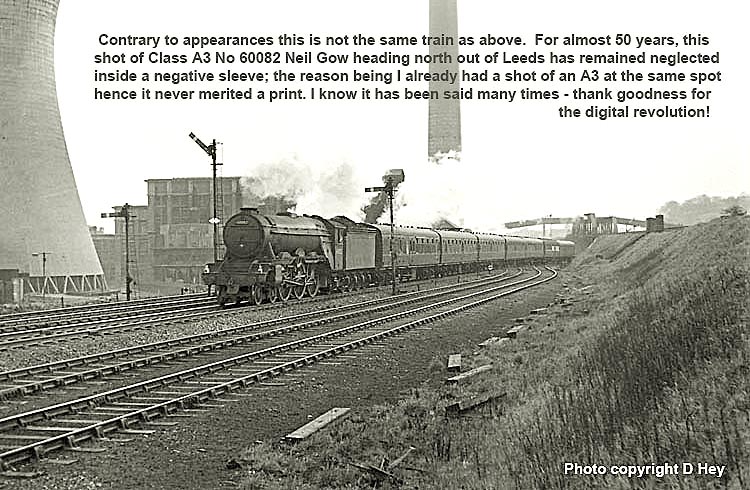

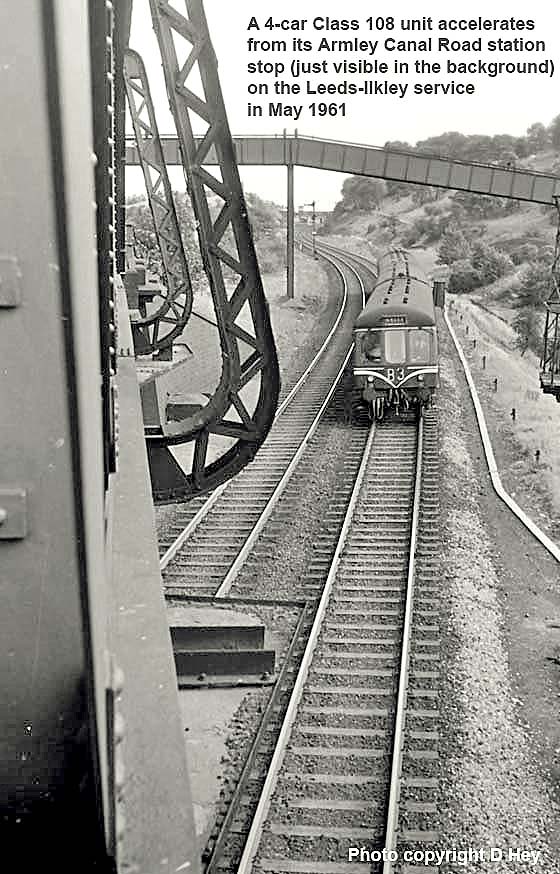
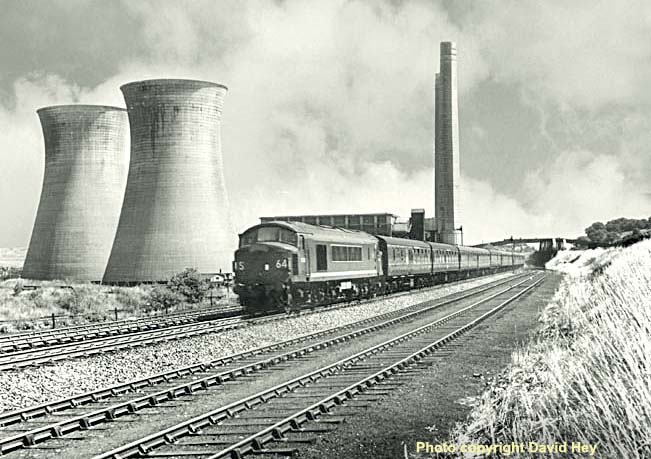
(Above-Below) At one time, the towering chimneys and giant cooling towers of the now-demolished Kirkstall Power Station could be seen from miles away, but they provide a somewhat less than satisfactory backdrop to this shot of 'Peak' class D30 heading the northbound 'Waverley' on 29 July 1961. Fast-forward to the present day, however, and one's perception on what constitutes a decent picture can change; now that the chimneys and cooling towers have long-since gone I can't imagine the photo without them! (Below) Adjacent to the site of Kirkstall Power Station is the grassy slopes of Gotts Park, home of Benjamin Gott, one of the pioneers of Leeds industry; back in steam days the panoramic view of trains in the valley was quite something... 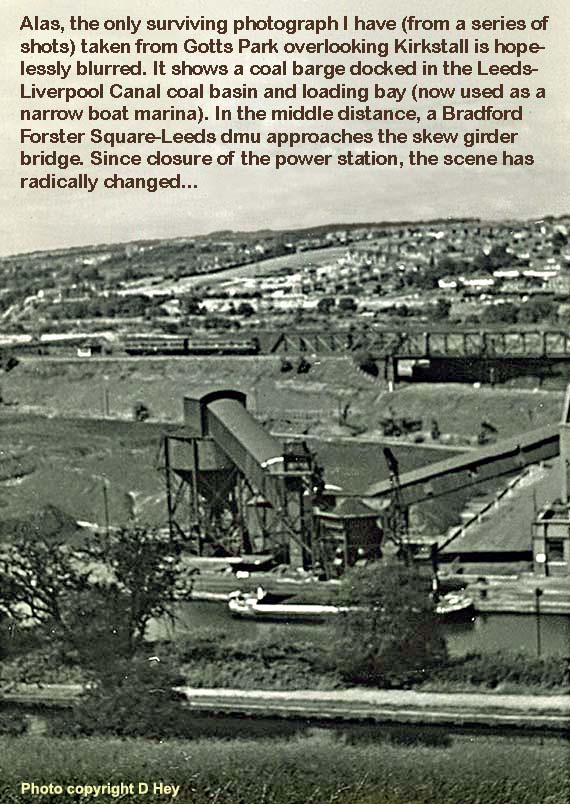
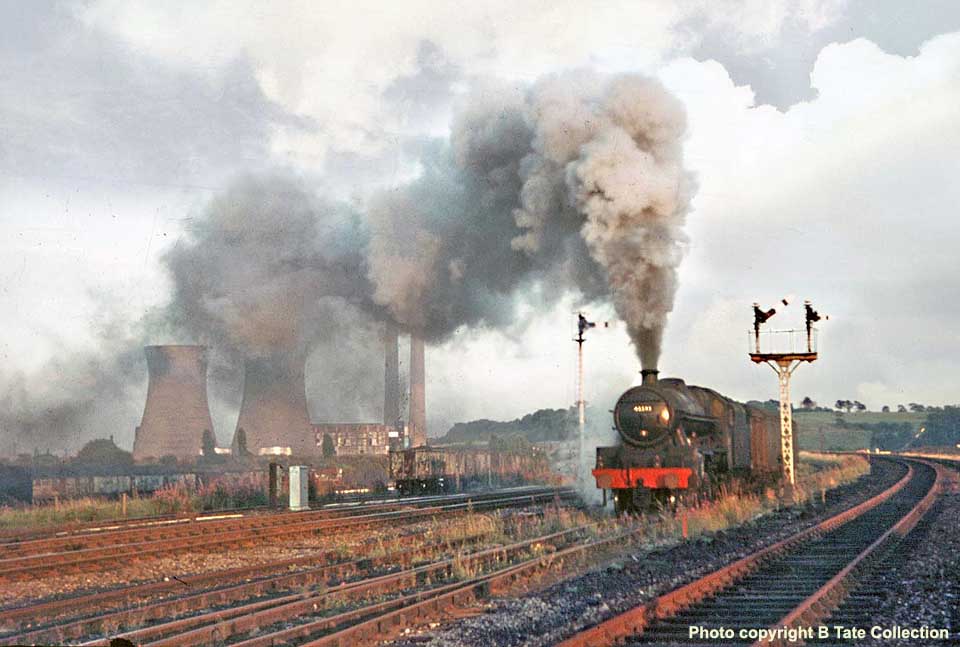
(Above-Below) In 1995 the Aire Valley line linking Leeds, Ilkley, Skipton and Bradford Forster Square was updated with multiple aspect signalling and 25kV overhead line equipment, and the only evidence of a flyover junction is the abandoned embankment carrying the 'fast' lines. Following closure of local passenger stations between Leeds and Shipley, the Aire Valley route was reduced to two tracks in 1967, retaining loops at Kirkstall for goods traffic. Here, 'Jubilee' class No 44593 Kolhapur gets the right away from the 'down' loop' in June 1966. (Below) A pair of 9F 2-10-0s - a combined weight of some 280 tons - provide super power for a Heysham-Hunslet tank train at Kirkstall Junction in June 1966. 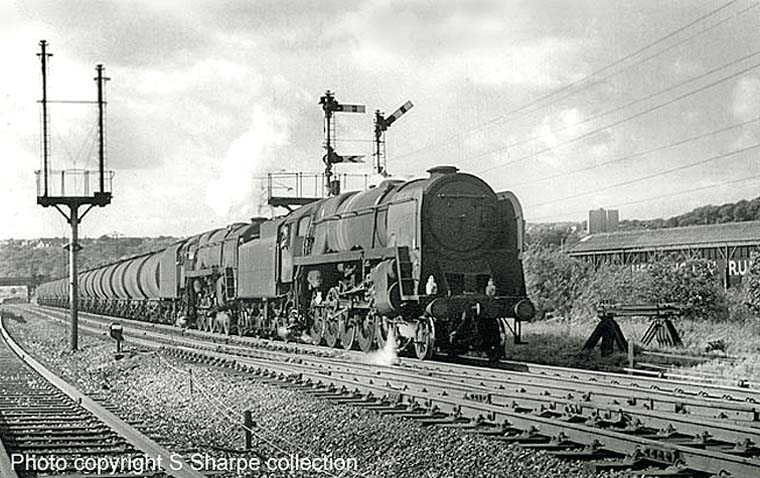


(Above) The rusting 'fast' lines are awaiting removal as an unidentified 'Black 5' heads a a southbound freight towards Leeds. The abandoned platforms at Kirkstall station can be seen beyond the bridge in the background. (Below) Upon completion of the Leeds signalling scheme in 1967, Kirkstall Junction became the fringe box to the new power box at Leeds. Beyond Kirkstall, however, traditional mechanical signalling remained a feature of the Aire Valley Line up to 1994 when a start was made on replacing semaphores with colour light signals between Leeds PSB to the new fringe box at Hellifield South Junction; this brought an end to eleven Midland signalboxes along the route. Stage one of the new signalling scheme began on June 4th with the closure of boxes at Kirkstall Junction, Apperley Junction, Guiseley Junction, Shipley Bingley Junction and Shipley Bradford Junction…Bingley became the temporary fringe box to Leeds. Stage two began in November 1994 with the closure of Bingley, Keighley Station Junction, Kildwick, Cononley, Skipton Station Junction and Skipton Station North Junction. Kirkstall Junction was opened as part of the quadrupling of the line between Leeds and Shipley; the roof of MR box is scarcely visible above the first carriage in this shot of preserved Class A3 4472 Flying Scotsman heading a Carnforth Steamtown special.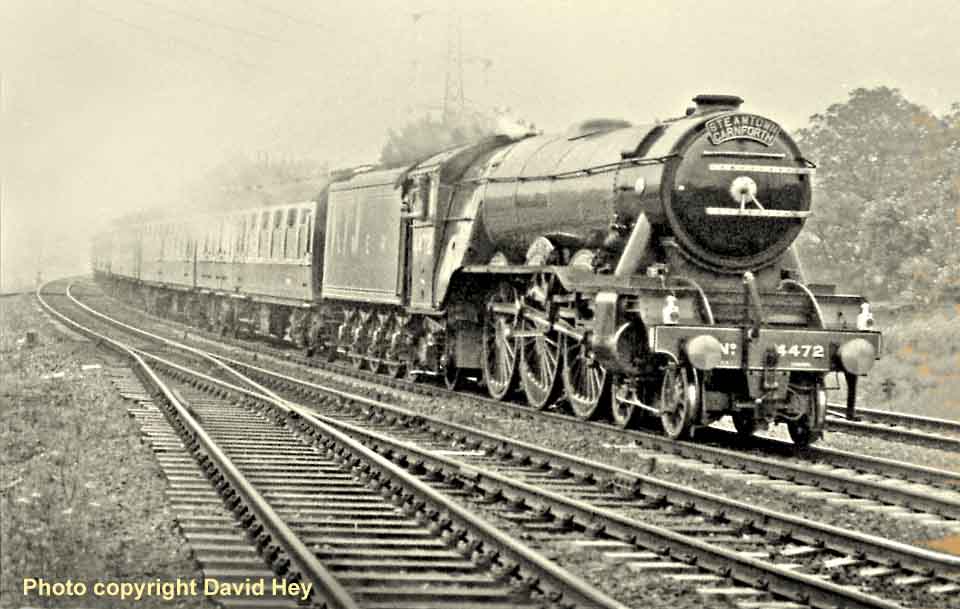
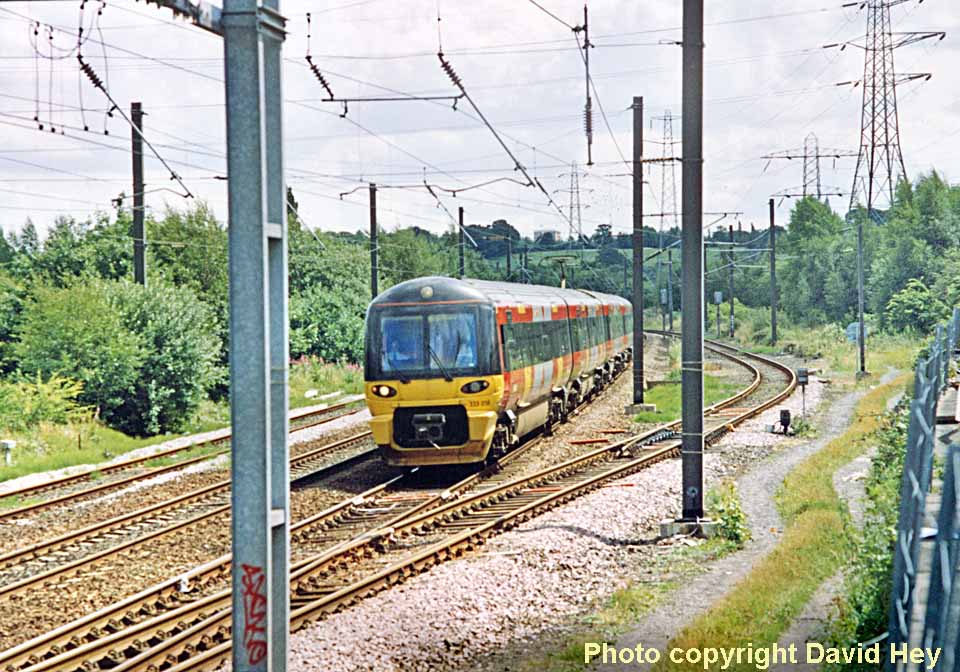
(Below) Following conversion of Kirkstall Power Station from coal to oil in 1973, the hoists, coal crushing machinery and coal storage area were removed, and the redundant Leeds-Liverpool Canal basin abandoned to nature. The power station was removed from the National Grid in 1976 and three years a later a start was made on demolishing the site, starting with the cooling towers. This series of photos was taken by Don Tate…link HERE to his 'Popmanstensguaard' Flick photostream which features a number of interesting shots of both 'old' and 'new' Leeds. 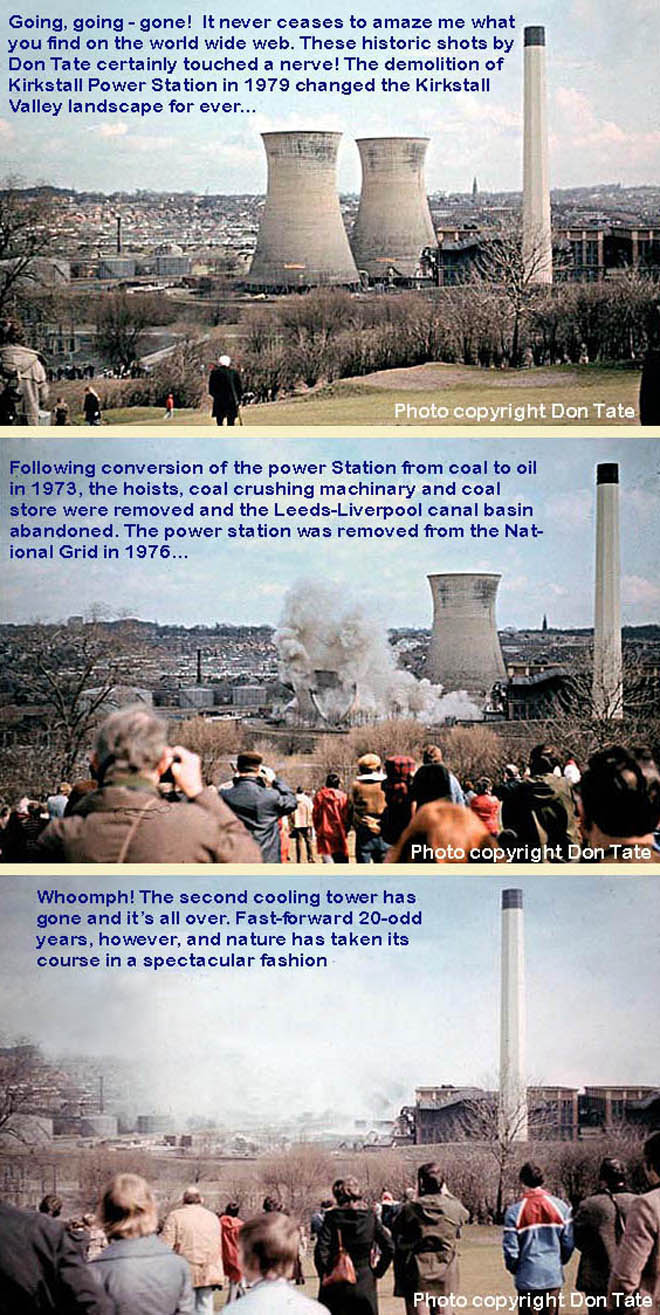
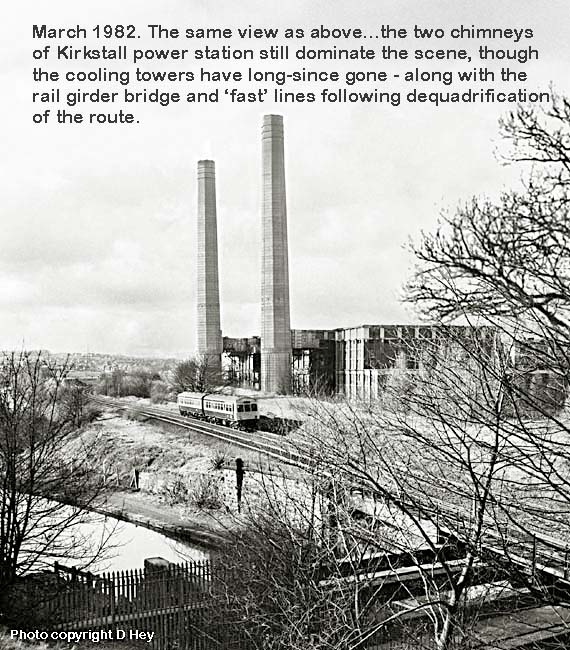
(Below) We take our leave of 'Aire Valley Line Part 1' with this photograph, taken from the bridge abutment in the shot above, showing Class 47 No 47004 crossing a rather murky-looking Leeds-Liverpool Canal with the 16.10 Leeds-Carlisle.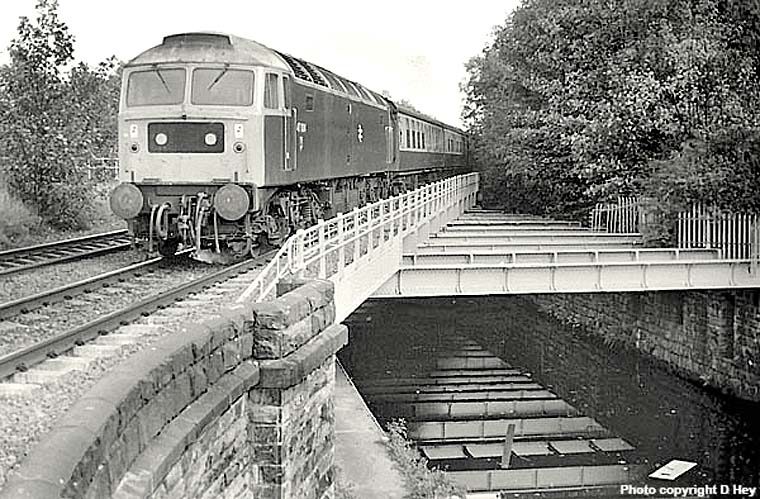
PART TWO - KIRKSTALL TO NEWLAY & HORSFORTH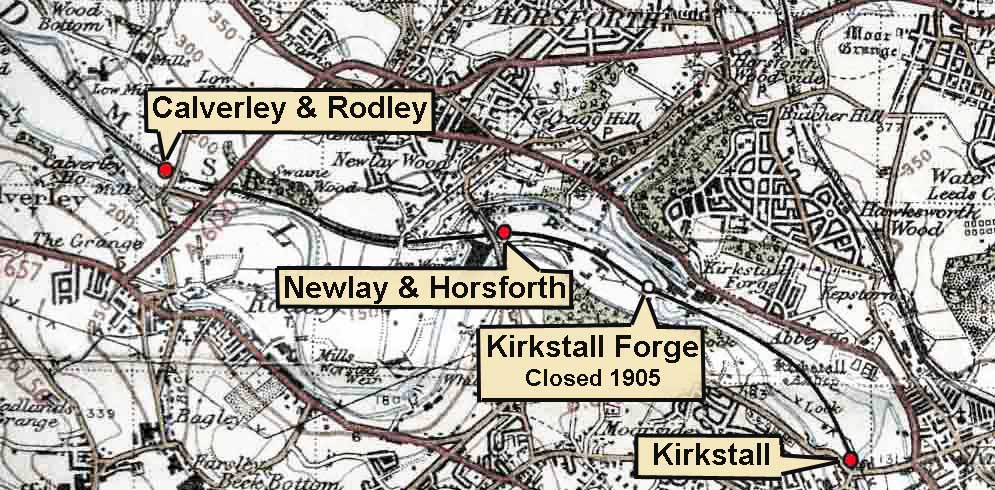
(Above) The popular series of Ordnance Survey One-Inch Maps were a great way of finding suitable trackside locations; railway cuttings, bridges, embankments and footpaths were clearly marked. This is a small section from a cloth-bound map No 96, costing 3/- (30P) first published in 1947 which shows the Leeds-Liverpool Canal running close by the railway opposite the Kirkstall Forge engineering works.
Of 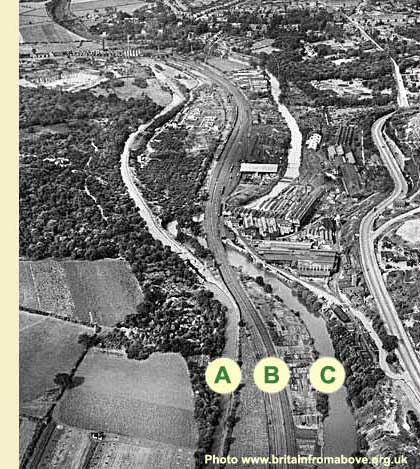 special interest were the two railway bridges across a bend in the river; it looked a promising location and was easily accessible by push bike along the tow path; from that point on the canal became a regular cycle route for photographing trains in the remotest parts of the valley. Click on map to enlarge the image.
special interest were the two railway bridges across a bend in the river; it looked a promising location and was easily accessible by push bike along the tow path; from that point on the canal became a regular cycle route for photographing trains in the remotest parts of the valley. Click on map to enlarge the image.
(Right) You will find a wonderful set of aerial photos of Kirkstall Forge on the 'Britain from the Air' website Click HERE. This view looking west shows the close proximity of 'A' Leeds-Liverpool Canal, 'B' Railway and 'C' River Aire in the Leeds suburbs.
(Below) Beyond Kirkstall Station the line passes through open arable farmland where the derelict remains of Kirkstall Abbey can be seen in the right background of this shot of a Class 4F heading a lightweight goods train towards Shipley. The abbey is one of the finest Cistercian ruins in the country; indeed the sprawling Kirkstall Forge engineering works, an area covering 65 acres, was founded by the Cistercian monks. It is thought a furnace was built to smelt iron ore for the production of nails and tools during the construction of the Abbey. The Forge works finally closed in 2003 bringing an end to 800-years of engineering there, and the whole site was bulldozed circa 2008, although the historic waterwheel, hammer shop, and slitting mill (built in 1676) have been saved. A new development is planned for the site featuring the restored waterwheel and slitting mill. Click here to visit Phil D's fantastic photos of a derelict Kirkstall Forge; his Flickr Photostream is well worth a visit...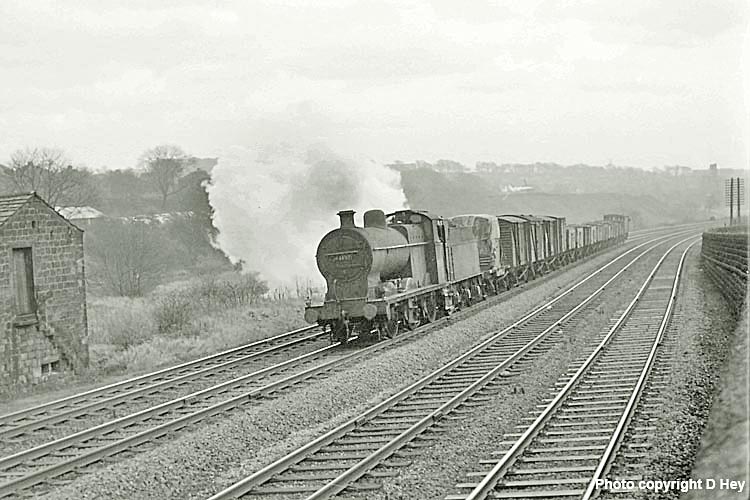
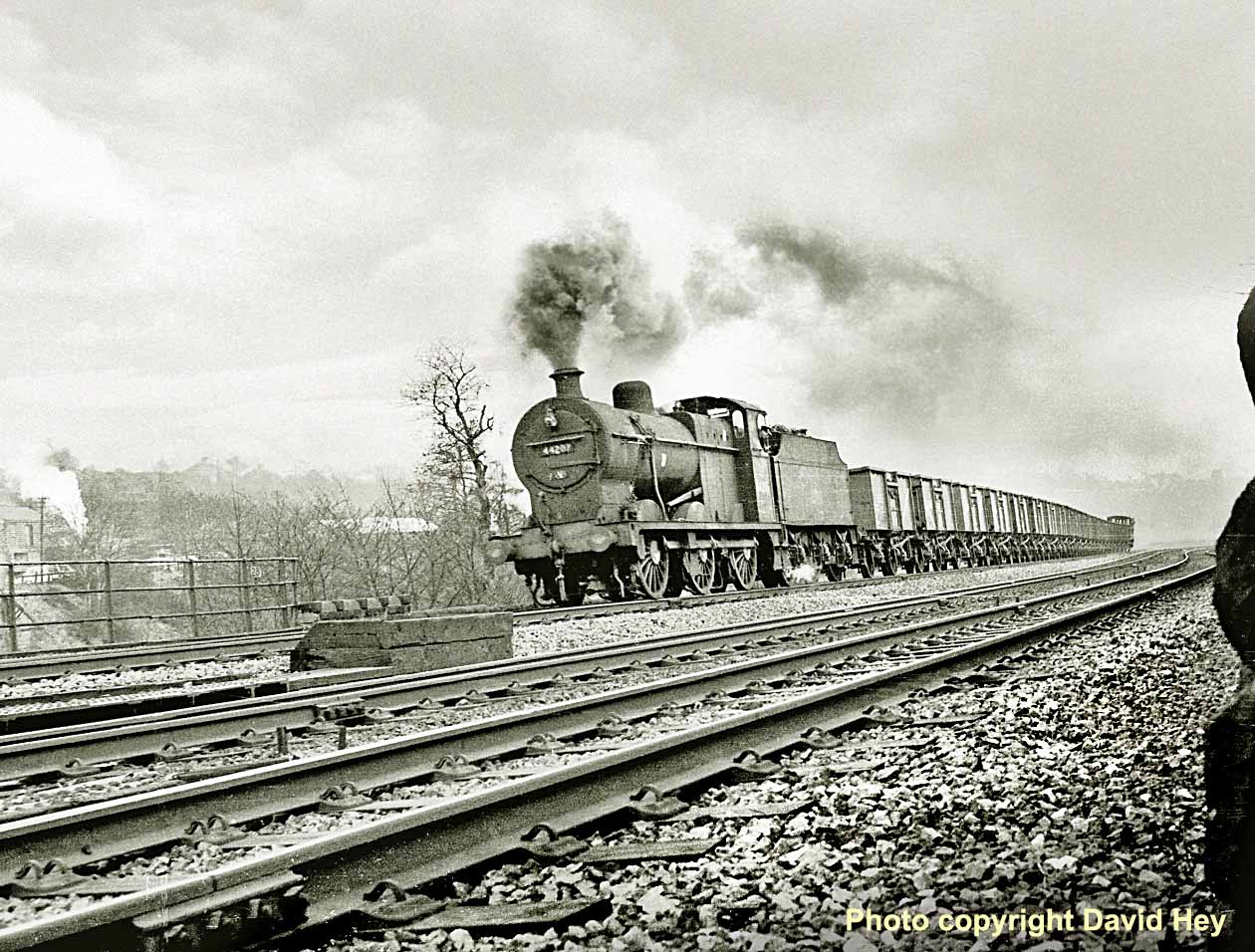
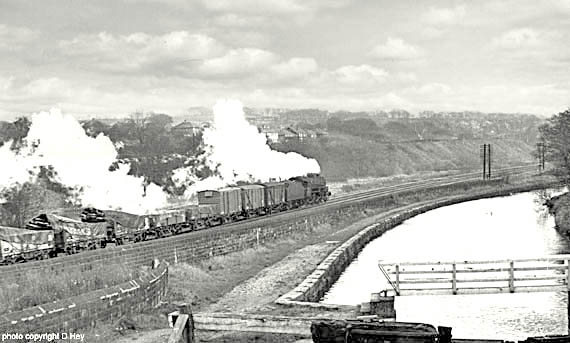
The Leeds-Liverpool Canal is noted for its staircase locks, where one lock opens into the one above; the most famous being the Five-Rise staircase locks at Bingley, an impressive piece of waterway engineering constructed during the Napoleonic Wars. Needless to say, the journey by horse-drawn barge across the Pennine hills, climbing to a height of 500ft above sea level just beyond Gargrave, with no fewer than 91 locks to negotiate between Leeds and Liverpool, was a painfully slow process, yet the canal provided substantial trade benefits for both Lancashire and Yorkshire businesses, particularly in the shipment of heavy goods such as coal. At Kirkstall the canal climbs through a set of 3-rise staircase locks opposite Kirkstall Forge, a popular location for this aspiring schoolboy photographer during steam days. The Forge Locks can be seen in these shots of a Hughes 'Crab' heading an 'up' freight (above) and in the opposite direction a low-level shot of 'Jubilee' class 45573 Newfoundland.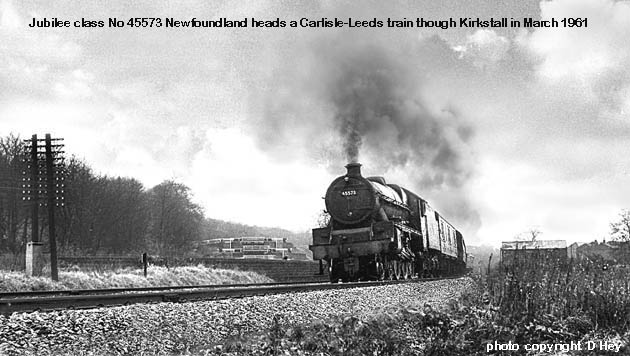
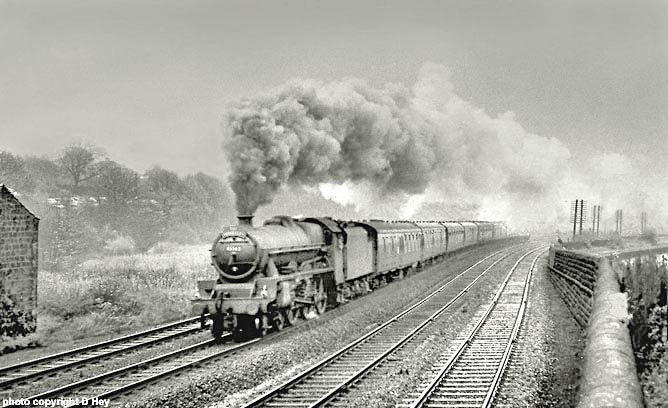
(Above-Below) 'Jubilee' class No 45562 Alberta heads the northbound 'Waverley' express in fine style alongside the Leeds & Liverpool Canal.
The canal not only provided a vital transport link for the woollen mills in the Aire valley, it was a popular venue for fishermen too. In fact, fishing was one of the biggest outdoor pursuits for boys during the Sixties - still is, come to that. Well, not wishing to incur the wrath of anglers, but I can't see the point in sitting on river banks for umpteen hours on end. It's hardly what I'd call 'firing on all cylinders'. Whatever incentive drove my angling-mad schoolmates to fish their local stretch of Leeds-Liverpool canal between Kirkstall and Rodley remains a mystery. On the other hand, my mates thought my compulsion for bagging 'cops' in a red, underlined exercise book was even dafter, which somehow evened the score!
But it didn't really matter what we thought because both groups had a lot in common. We were both driven by the same Zion-style love of the great outdoors and being close to nature, we enjoyed the same level of high-octane excitement interspersed by long periods of suspenseful waiting - and, after a long day's fishing or train spotting, we looked like something the cat had dragged in!
The only difference between us, if I have to find one, is that by the very nature of the sport, anglers tended to be loners, and if they're fishing in a competition it's not enough that they succeed; others must fail. Train spotting was a much more exciting pursuit in my view. The biggest thrill of all was hearing the tell-tale rustle of signal wires which never failed to stimulate a sense of expectancy at what might happen next...though with the influx of boring dmus gathering pace, there was a real danger of rigor mortis setting in. This 2-car Derby unit (below) is crossing the fast flowing Aire river on a Leeds-Ilkley service.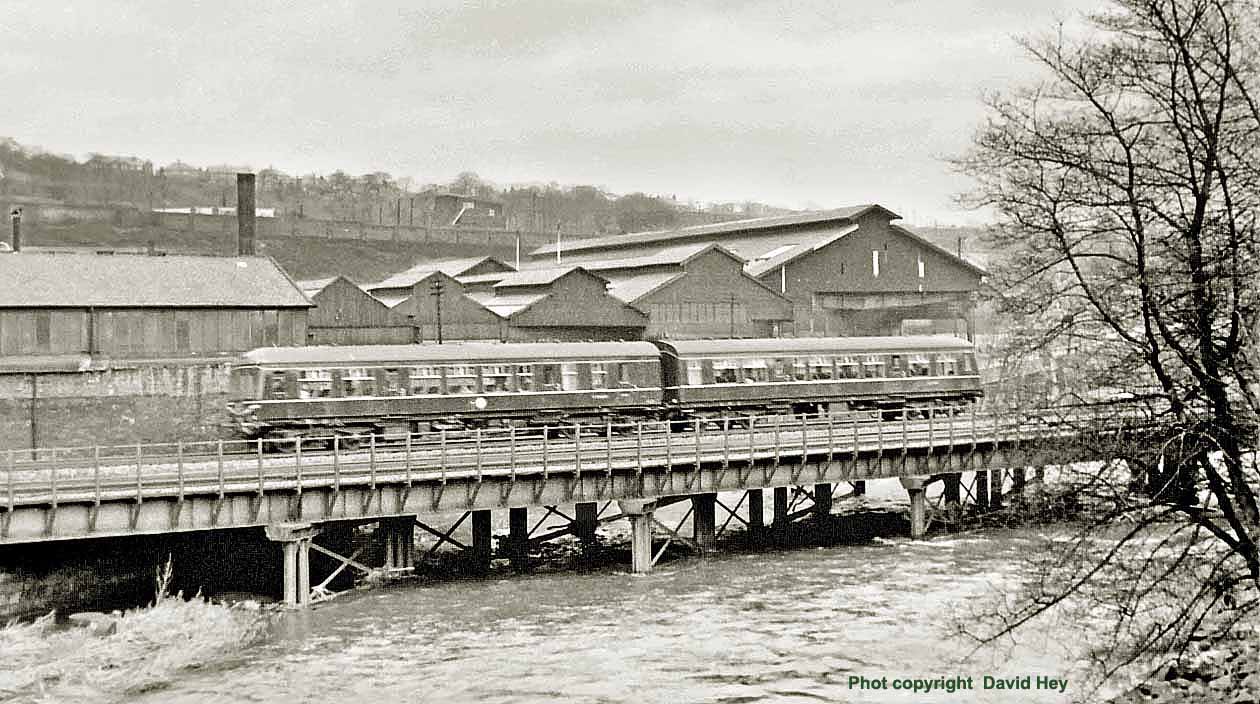

(Above-Below) If anyone had told me that one day I'd get the chance to photograph a 'Duchess' on the 'Caledonian' express at Kikstall, albeit in its preserved form some twenty-odd years later, I'd never have believed it! Following reduction of the route to two lines, the abandoned trackbed is still conspicuous today, particularly on bridges where the line crosses the River Aire and Leeds & Liverpool Canal...the bottom photograph shows the same scene today. The track has been slewed to raise the speed limit and the Aire Valley route is now updated with multiple aspect signalling and 25KV overhead line equipment - not surprisingly, local anglers are warned not to fish nearby. Philip Hardaker's lovely shot of a Northern Rail-WYPTE Metro Siemens Class 33 emu skirting the Leeds-Liverpool canal clearly shows the green urban corridor surrounded by woodland a little over four miles from the city centre; Kirkstall Abbey can be seen beyond the trees in the distance.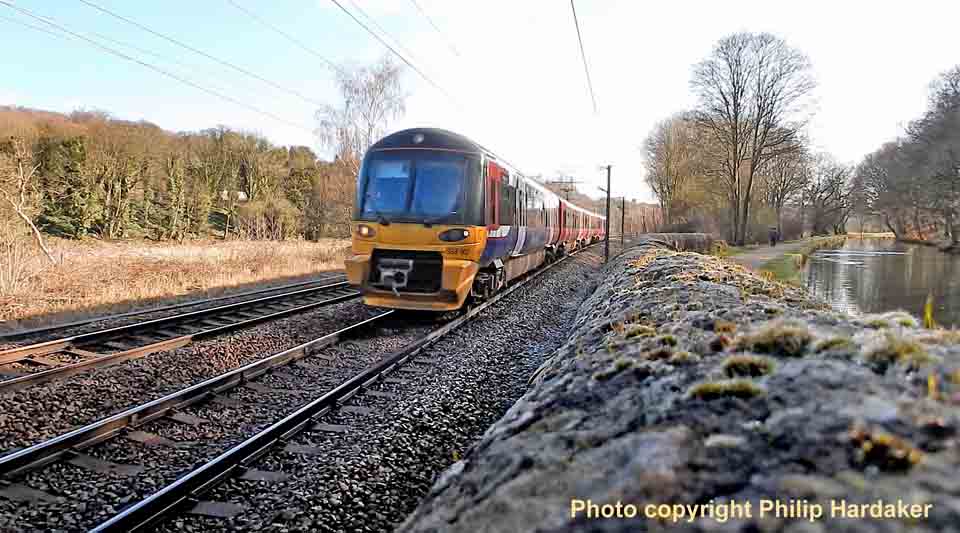

(Above-Below) Having invested in yet another replacement slide scanner - the previous one gasped its last breath and refused to give up the negative strip locked in its jaw, so too did the scanner I used before that! Perhaps I'm doing it wrong! Anyway, another start has been made on resuscitating 50 year-old negatives (digitalizing) including this one of BR Standard Class 5 No 73168, which was scanned from the actual negative to replace a below-par scanned photo previously used. Just visible in the left background is the abandoned Kirkstall Forge station, which closed in 1905 when the line between Leeds and Shipley was increased to four tracks. The old station building is featured in Keth Rigby's computer simulation below.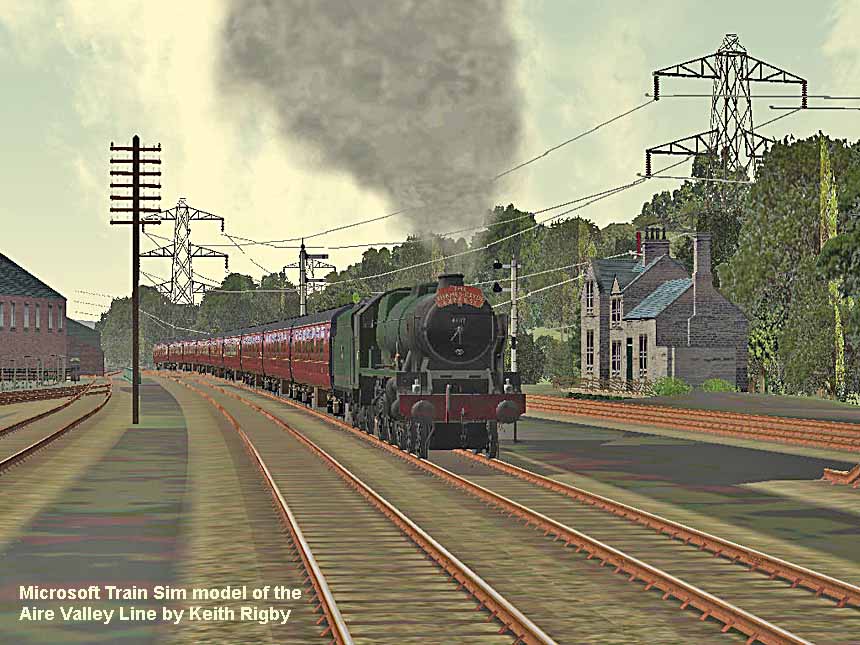
(Below) The Stanier 'Royal Scots' - oh, what a handsome engine they were! Even without their curved smoke deflectors tucked around the smokebox, the rebuilt version of Fowler's original parallel boilered 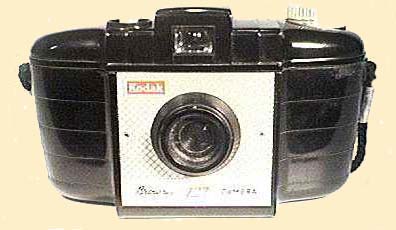 engines looked pleasing to the eye from every angle, so I hope you'll forgive inclusion of this oldie from June 1958. Having borrowed my sister's Kodak Brownie 127 - to finish off the tail-end of a last year's family holiday film - this was one of my first attempts at railway photography, and I was pleased as Punch with the result…still am, come to that! It shows 'Royal Scot' class 46145 The Duke of Wellington's Regt (West Riding) heading the 'up' 'Thames-Clyde Express' past Kirkstall Forge works.
engines looked pleasing to the eye from every angle, so I hope you'll forgive inclusion of this oldie from June 1958. Having borrowed my sister's Kodak Brownie 127 - to finish off the tail-end of a last year's family holiday film - this was one of my first attempts at railway photography, and I was pleased as Punch with the result…still am, come to that! It shows 'Royal Scot' class 46145 The Duke of Wellington's Regt (West Riding) heading the 'up' 'Thames-Clyde Express' past Kirkstall Forge works. 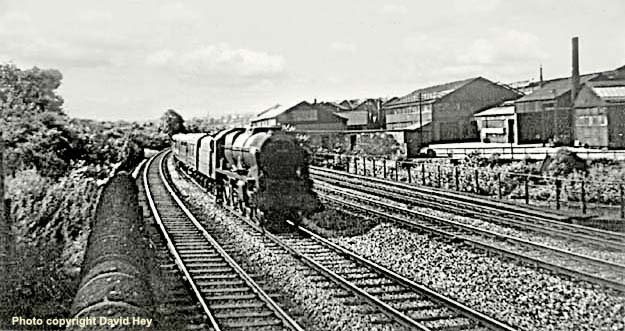
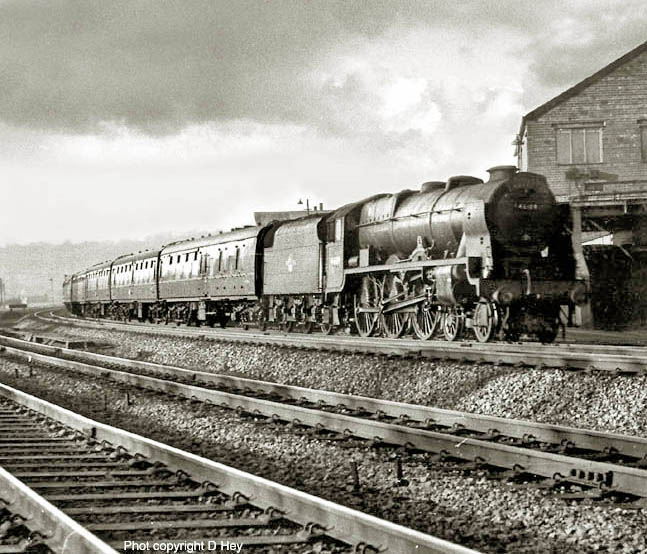
(Above-Below) Fast-forward a couple of years and I scrimped and saved to buy an expensive-looking Halina 35X camera (below-left) from mum's mail-order catalogue, costing the princely sum of £7/13/6d - a lot of dosh for a cash-strapped youngster - but what a difference it made. Being in possession of a 35mm camera was the 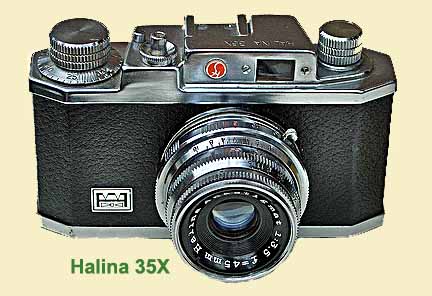 defining moment that changed everything; with the typical youthful impetuosity, I no longer wanted to be an engine driver, I wanted to be a professional railway photographer. I had no way of knowing that this beautiful engineered camera would let me down so spectacularly!
defining moment that changed everything; with the typical youthful impetuosity, I no longer wanted to be an engine driver, I wanted to be a professional railway photographer. I had no way of knowing that this beautiful engineered camera would let me down so spectacularly!
In April 1960, after spending the whole day photographing trains in the Lune Valley (see Page 13) I began to rewind the exposed film back into the cassette when the rewind handle suddenly slackened off; instead of hearing the resistant sound of celluloid passing from one sprocket to the other, the camera gave out an ominous 'plop!' as if the film had wound back instantly. Either I had fed the leader (the length of trimmed film) into the fixed spool incorrectly, or the sprocket wheels (used for advancing the film to the next frame) had come loose, and I feared the film had jammed inside the camera.
But I had to wait an agonizing whole week before finding out; one-hour film processing was unheard of in the 1960s. Sure enough, on collecting the pictures from the chemist, there wasn't a single print - and on examining the negatives against the light, apart from a jumbled mass of super-imposed images over the first  frame, the rest of the film was blank.
frame, the rest of the film was blank.
Several weeks later I replaced the Halina camera with a second-hand Agfa Sillette 35mm camera (right) and in August 1960 returned to the Aire Valley Line at Kirkstall to take this much-improved shot (above) of No 46109 Royal Engineers heading the 'up' 'Thames-Clyde Express'. (Below) By October, the motive power on the Aire Valley Line was radically changing with the arrival of the Class A3s from Tyneside. Here No 60092 Fairway heads the 'up' 'Thames-Clyde Express' past Kirkstall Forge during a torrential downpour on 27th October 1960. 
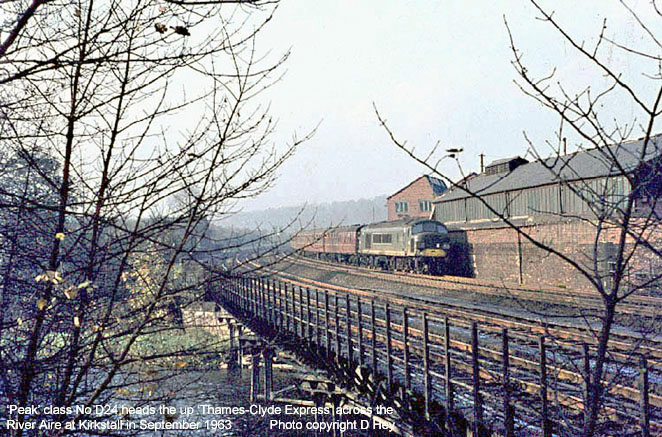
(Above) Fast-forward another couple of years and the motive power has changed yet again - and so too has the photo equipment, a single lens reflex camera bought on 'tick' from Dixons. The Kowa E (left) 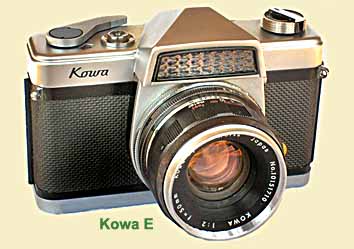 had a fixed 50mm f/2 lens and a top shutter speed of 1/500sec, which was fast enough to 'freeze' the speediest train…well, almost.
had a fixed 50mm f/2 lens and a top shutter speed of 1/500sec, which was fast enough to 'freeze' the speediest train…well, almost.
Above all else, the camera had a built-in match-needle selenium meter which was the perfect solution to ending years of calamitous second-guessing exposure settings.
(Below Right) It seems 'hip' and 'cool' nowadays to take a 'selfie' and share it on social networking sites Facebook and Twitter. This is my self-portrait - what a poseur! - when testing the new SLR 35mm camera in the mirror. In those days a self  portrait was usually taken by setting a self-timing shutter and running around the camera into the picture, often with laughable results...but more importantly, the camera now gave me a chance to take some 'proper' steam action shots. And I did...lots of them, but it was all to no avail! Thirty-odd years later and the bulk of my 35mm railway negatives plus hundreds of colour transparencies were destroyed in a catastrophic fire - a long story which I tell elsewhere on this site. Needless to say, the memorabilia I lost was stomach-churning - it meant more to me than anything in the world - a pageant of memories gone up in smoke forever.
portrait was usually taken by setting a self-timing shutter and running around the camera into the picture, often with laughable results...but more importantly, the camera now gave me a chance to take some 'proper' steam action shots. And I did...lots of them, but it was all to no avail! Thirty-odd years later and the bulk of my 35mm railway negatives plus hundreds of colour transparencies were destroyed in a catastrophic fire - a long story which I tell elsewhere on this site. Needless to say, the memorabilia I lost was stomach-churning - it meant more to me than anything in the world - a pageant of memories gone up in smoke forever.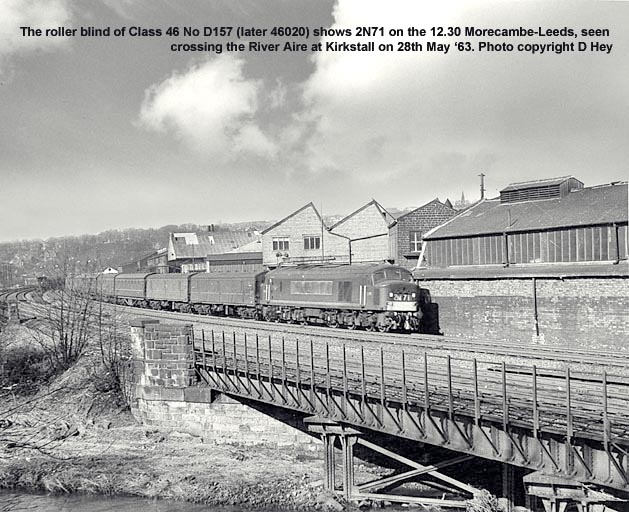

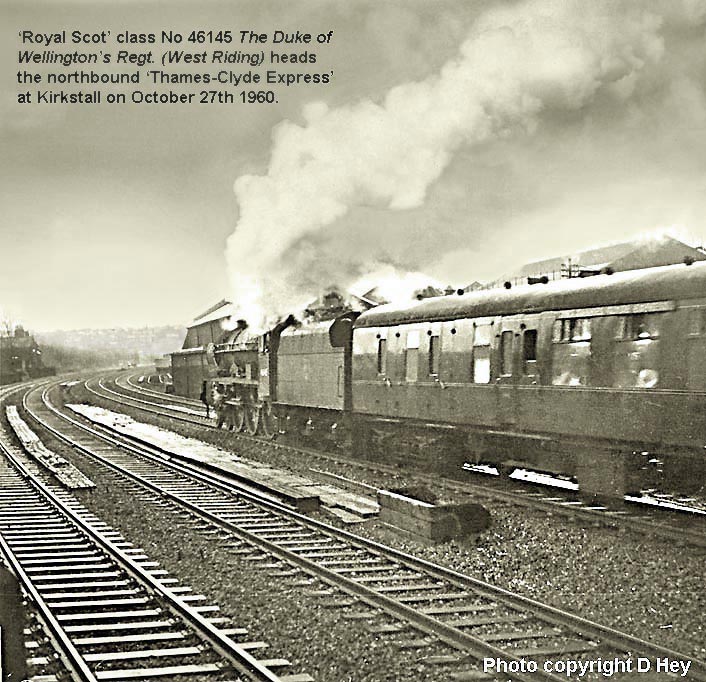
(Above-Below) 'Royal Scot' class No 46145 The Duke of Wellington's Regt. (West Riding) heads the 'down' 'Thames-Clyde Express' over the Rive Aire adjacent to Kirkstall Forge on October 27th 1960. The remains of Kirkstall Forge station (opened on 1 July 1860) can be seen on the left. The station closed on 31 July 1905 when the line was quadrupled. Fast-forward to the present day and a new rail station is being built at Kirkstall Forge by WYCA, in partnership with Network Rail, Northern Rail and Commercial Estates Group (CEG). The station will initially be served by two trains per hour in each direction between Leeds and Bradford Forster Square. Trains are expected to begin using the station in August 2015. (Below) Comparison can be made with this going-away shot of the 'Duchess' heading the 'Caledonian' featured earlier on this page. 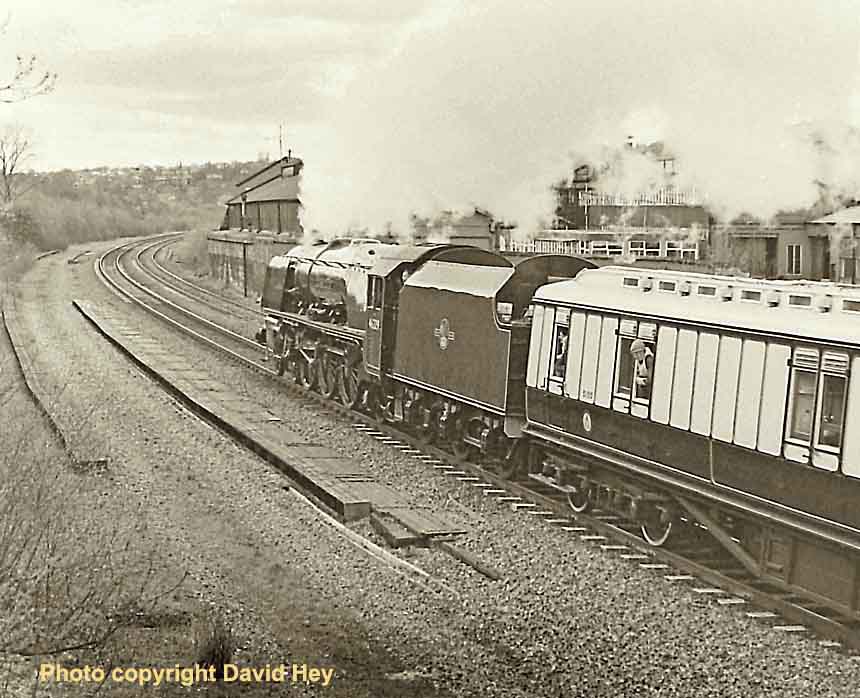

(Above-Below) Adding to the locomotive variety at Kirkstall is this rather grubby BR Standard Class 4MT No 76022 heading a Leeds-Morecambe train in March 1961. Numbered 76000-76114 in the fleet, the BR4's low axle load gave them a wide route availability, but by the mid-Sixties the volume of traffic on BR's secondary routes was rapidly decreasing and a more useful Class 3 (Nos 77000-19) would have sufficed. The last of the Class, No 76114, has the distinction of being the final steam locomotive built at Doncaster Plant in 1957. (Below) Class 8F No 48160 heads a long rake of coal empties towards Leeds.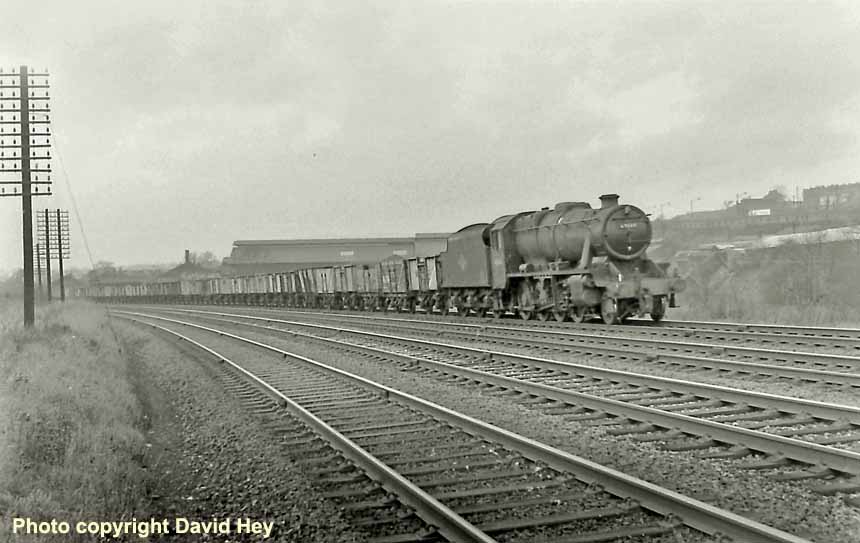
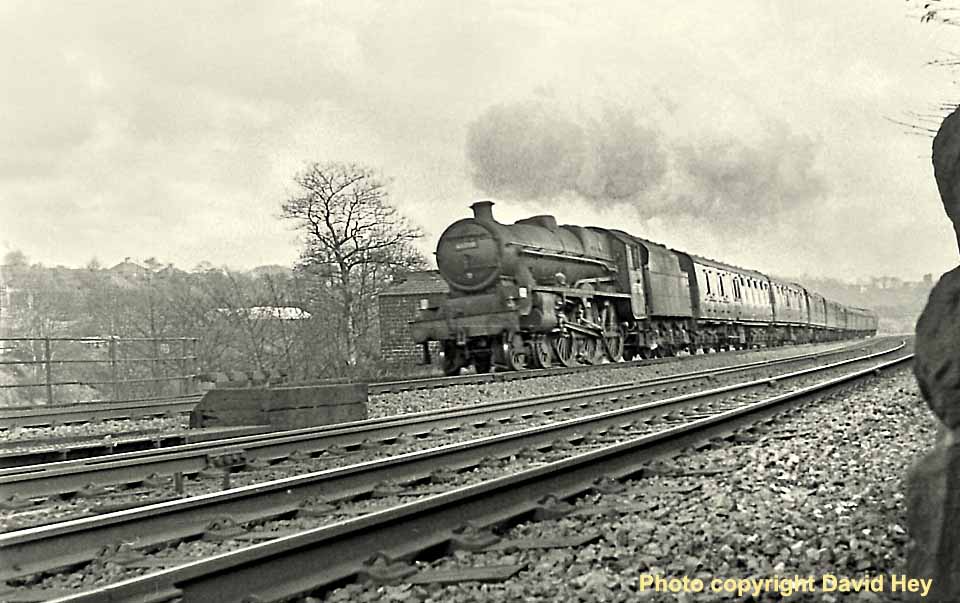
(Above-Below) Regular visitors to these pages will notice a change in some of the photographs; indeed one of the reasons for updating the three Aire Valley pages is to try and improve the photographic quality. Back in the Sixties all exposed films were dropped off at the local chemist. who then sent them away to be developed and machine-printed at a processing laboratory. Sadly the results were often disappointing; a lot of photos were under or over exposed (either too light or too dark) due to the lack of 'burning' and 'dodging' during the printing stage; as a result many photos were regarded as 'failures' and finished up in the bottom of a drawer. This happened to a photo of 'Jubilee' class 45730 Ocean heading the northbound 'Waverley' at Kirkstall on 11th November 1960…it was totally 'frazzled' with no half-tones in it at all, however this basic digital scan of the 35mm negative has produced an acceptable result some fifty-odd years later; the same can be said for the shot of Class 8F No 48274 heading a 'down' goods train on the same day, albeit the image is not 'picture perfect' it is better than none. The remains of Kirkstall Abbey are just visible in the background. 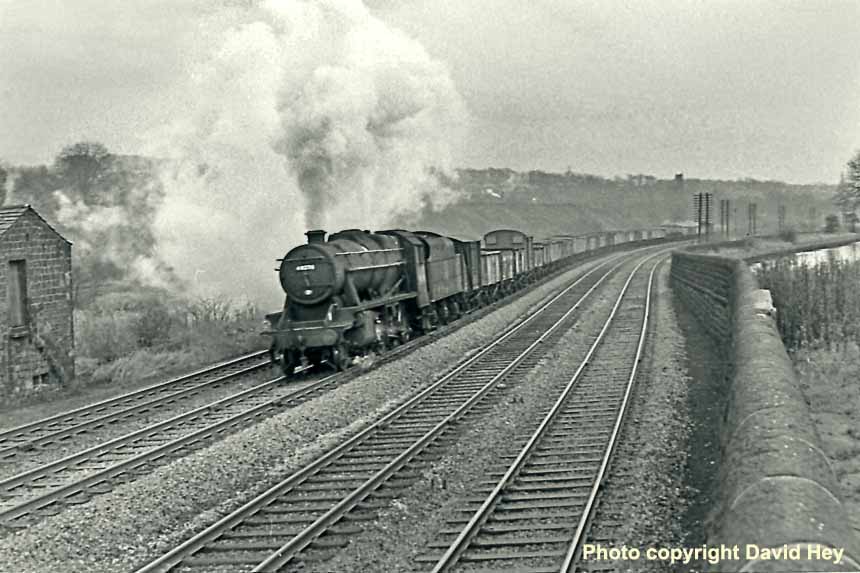
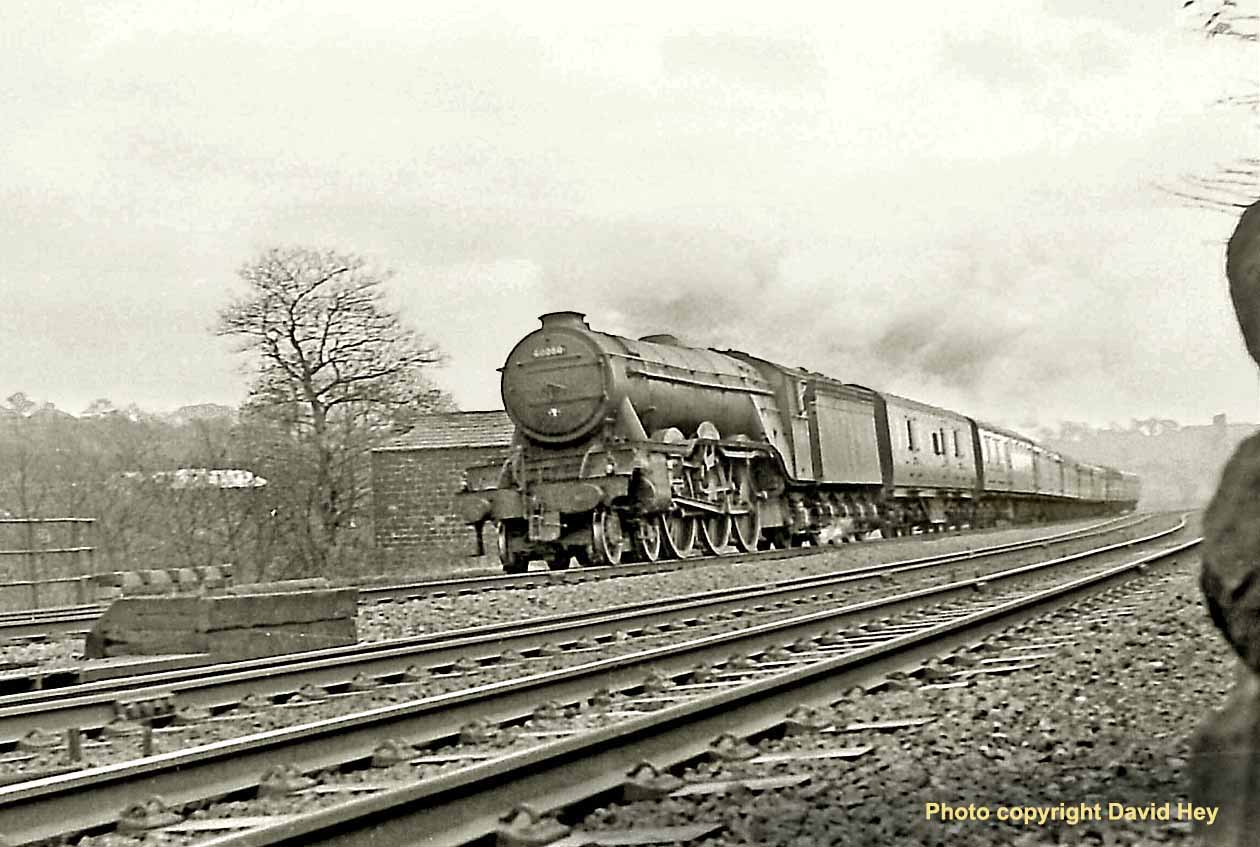
(Above-Inset-Below) I'm sure there are many 'old timers' (pre-digital cameramen) who remember 'dabbing' away at niggling white spots on a print with a ballpoint pen, trying to remove unsightly blemishes caused by contaminated chemicals, or perhaps dust and hairs on the lens - and the worst enemy of all, old age. Whatever the reason, most blemishes can be digitally removed relatively easily nowadays using Adobe Photoshop, a veritable computer darkroom complete with a toolbox that holds all the tools you need to work on photo-retouching, such as removing spots or other unsightly blemishes. For example this shot of Class A3 No 60080 Dick Turpin heading a Leeds-Glasgow express suffers from what I suspect is a chemical  spill - a half-moon shape bleached into the foreground track - hence the picture has always been cropped, until now. (Inset) However, in this particular case it seems the camera strap has got in the way of the lens when taking this shot of Ivatt's Class 2 2-6-0 No 46497 heading the 'up' 'Devonian' past Kirkstall Forge on 11th November 1960…no through the lens (affordable SLR cameras) in those days for this cash-strapped schoolboy earning a pittance from his morning paper round!
spill - a half-moon shape bleached into the foreground track - hence the picture has always been cropped, until now. (Inset) However, in this particular case it seems the camera strap has got in the way of the lens when taking this shot of Ivatt's Class 2 2-6-0 No 46497 heading the 'up' 'Devonian' past Kirkstall Forge on 11th November 1960…no through the lens (affordable SLR cameras) in those days for this cash-strapped schoolboy earning a pittance from his morning paper round!
(Below) Fast-forward to the present day, however, and it has taken a bit of jiggery-pokery in Photoshop to put things right; indeed photo-manipulation is commonplace nowadays, and I'm not talking here about air-brushing a super model's blemishes. Who cares, anyway? What should be the biggest concern is the way photo-manipulation is used by the news media, raising the issue of ethics in photo-journalism. It begs the question how far you can push the boundaries of digital image manipulation and still maintain an acceptable level of integrity. For example, photo manipulation creates an illusion, which, by its very nature is a deception, so while I admit to adding skies to some photographs (to enhance an otherwise bleached-out image) it does raise concerns about the ethics of it. But then, it is vastly different than, say, changing the number of a locomotive, which smacks of foul play, and I definitely draw the line at that! A page devoted to Photoshopping railway images can be found HERE...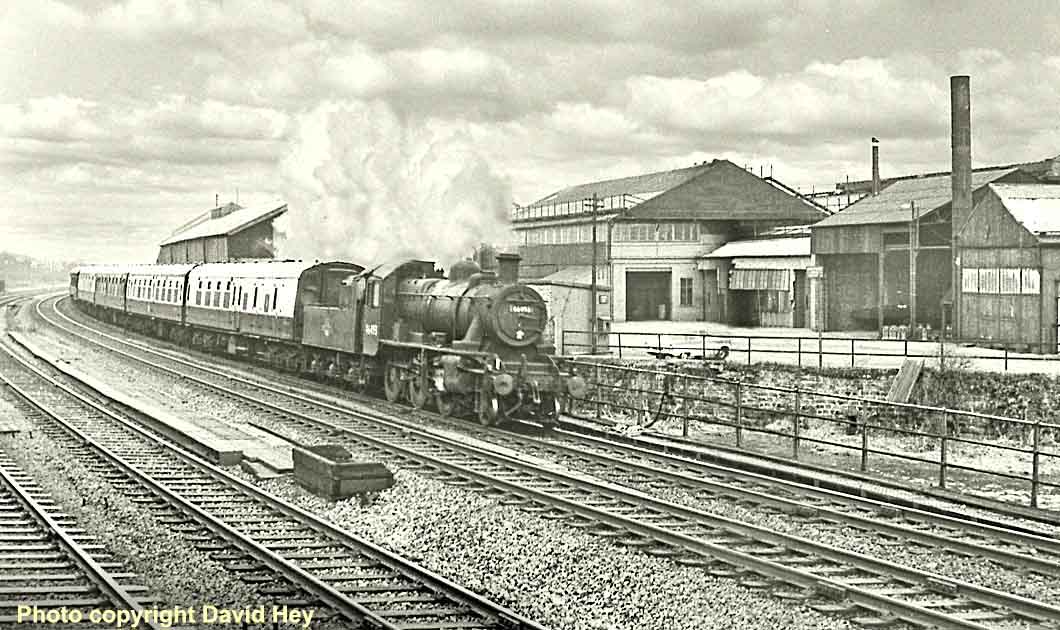
PHOTO GALLERY
Polite notice: All text and photographs are protected by copyright and reproduction is prohibited without the prior consent of the © owners. If you wish to discuss using the contents of this page the email address is below. Please note - this is not a 'clickable' mail-to link via Outlook Express. You will have to email manually.
dheycollection@ntlworld.com

